PROJECT DEMO: Northwind SQL Database
The Northwind SQL Database Project demonstrates how to use SQL queries and hypothesis testing in order to recommend business strategies for increasing sales and reducing costs for the fictitious “Northwind” company. The Northwind SQL database was created by Microsoft for data scientists to practice SQL queries and hypothesis testing in their analyses.

Hypothesis Testing
Below are 4 hypotheses (each including a null hypothesis and alternative hypothesis) which I will test for statistical significance to determine if there are any relationships which would be useful from a strategic business perspective. Following this I will summarize the results, make final recommendations, and propose ideas for future analytical work.
Objectives
H1: Discount and Order Quantity
Does discount amount have a statistically significant effect on order quantity? If so, at what level(s) of discount?
H2: Countries and Order Quantity: Discount vs Full Price
Do order quantities of individual countries differ when discounted vs full price?
H3: Region and Order Revenue
Does region have a statistically significant effect on average revenue per order?
H4: Month and Order Quantity
Does time of year have a statistically significant effect on average revenue per order?
Process Outline
Outline of process I will follow in order to answer questions above:
-Question
- Hypotheses
- Exploratory Data Analysis (EDA)
-Select dataset -Group data -Explore data
-
Assumption Tests: -Sample size -Normality and Variance
-
Statistical Tests: -Statistical test -Effect size (if necessary) -Post-hoc tests (if necessary)
-
Summarize Results
Statistical Analysis Pipeline
For #3 and #4 above (Assumption and Statistical Tests):
- Check if sample sizes allow us to ignore assumptions by visualizing sample size comparisons for two groups (normality check).
- Bar Plot: SEM (Standard Error of the Mean)
- If above test fails, check for normality and homogeneity of variance:
- Test Assumption Normality:
- D’Agostino-Pearson: scipy.stats.normaltest
- Shapiro-Wilik Test: scipy.stats.shapiro
- Test for Homogeneity of Variance:
- Levene’s Test: scipy.stats.levene) Parametric tests (means) Nonparametric tests (medians) 1-sample t test 1-sample Sign, 1-sample Wilcoxon 2-sample t test Mann-Whitney tes One-Way ANOVA Kruskal-Wallis, Mood’s median tes Factorial DOE with one factor and one blocking variable Friedman test
- Test Assumption Normality:
- Choose appropriate test based on above
- T Test (1-sample)
stats.ttest_1samp()
- T Test (2-sample)
- stats.ttest_ind()
- Welch’s T-Test (2-sample)
- stats.ttest_ind(equal_var=False)
- Mann Whitney U
- stats.mannwhitneyu()
- ANOVA
- stats.f_oneway()
- T Test (1-sample)
- Calculate effect size for significant results.
- Effect size:
- cohen’s d
-Interpretation:
- Small effect = 0.2 ( cannot be seen by naked eye)
- Medium effect = 0.5
- Large Effect = 0.8 (can be seen by naked eye)
- Effect size:
- If significant, follow up with post-hoc tests (if have more than 2 groups)
- Tukey’s
- statsmodels.stats.multicomp.pairwise_tukeyhsd
- Tukey’s
Contact
If you want to contact me you can reach me at rukeine@gmail.com.
License
This project uses the following license: MIT License.
#
# /\ _ _ _ * *
# /\_/\ /__\__|_|_____|_|__________________________| |________________________
# [===] / /\ \ | | _ | _ | _ \/ __/ -__| \| |_ _| _ \ \_/ /| * _/| | |
# \./ /_/ \_\|_| |_|_|_| |_|__/\_\ \______|_|\__| |_| |__/\_\___/ |_|\_\|_|_|
# | | |___/
# |_|
Project Demo
# connect to database / import data
import sqlite3
conn = sqlite3.connect('Northwind_small.sqlite')
cur = conn.cursor()
# function for converting tables into dataframes on the fly
def get_table(cur, table):
cur.execute(f"SELECT * from {table};")
df = pd.DataFrame(cur.fetchall())
df.columns = [desc[0] for desc in cur.description]
return df
# create dataframe of table names for referencing purposes
cur.execute("""SELECT name from sqlite_master WHERE type='table';""")
df_tables = pd.DataFrame(cur.fetchall(), columns=['Table'])
df_tables
| Table | |
|---|---|
| 0 | Employee |
| 1 | Category |
| 2 | Customer |
| 3 | Shipper |
| 4 | Supplier |
| 5 | Order |
| 6 | Product |
| 7 | OrderDetail |
| 8 | CustomerCustomerDemo |
| 9 | CustomerDemographic |
| 10 | Region |
| 11 | Territory |
| 12 | EmployeeTerritory |
H1: Discount–Quantity
- Does discount amount have a statistically significant effect on the quantity of a product in an order?
- If so, at what level(s) of discount?
Hypotheses
- $H_0$: Discount amount has no relationship with the quantity of a product in an order.
-
$H_A$: Discount amount has a statistically significant effect on the quantity in an order.
- $\alpha$=0.05
EDA
Select the proper dataset for analysis, perform EDA, and generate data groups for testing.
Select dataset
df_orderDetail = get_table(cur, 'OrderDetail')
df_orderDetail.head()
| Id | OrderId | ProductId | UnitPrice | Quantity | Discount | |
|---|---|---|---|---|---|---|
| 0 | 10248/11 | 10248 | 11 | 14.0 | 12 | 0.0 |
| 1 | 10248/42 | 10248 | 42 | 9.8 | 10 | 0.0 |
| 2 | 10248/72 | 10248 | 72 | 34.8 | 5 | 0.0 |
| 3 | 10249/14 | 10249 | 14 | 18.6 | 9 | 0.0 |
| 4 | 10249/51 | 10249 | 51 | 42.4 | 40 | 0.0 |
Group
# check value counts for each level of discount
df_orderDetail['Discount'].value_counts()
0.00 1317
0.05 185
0.10 173
0.20 161
0.15 157
0.25 154
0.03 3
0.02 2
0.01 1
0.04 1
0.06 1
Name: Discount, dtype: int64
# insert boolean column showing whether or not an order was discounted
df_orderDetail['discounted'] = np.where(df_orderDetail['Discount'] == 0.0, 0, 1)
# compare number of discount vs fullprice orders
df_orderDetail['discounted'].value_counts()
0 1317
1 838
Name: discounted, dtype: int64
# split orders into two groups (series): discount and fullprice order quantity
fullprice = df_orderDetail.groupby('discounted').get_group(0)['Quantity']
discount = df_orderDetail.groupby('discounted').get_group(1)['Quantity']
Explore
diff = (discount.mean() - fullprice.mean())
diff
5.394523243866239
# visually inspect differences in mean and StDev of distributions
sns.set_style("whitegrid")
%config InlineBackend.figure_format='retina'
%matplotlib inline
fig = plt.figure(figsize=(10,8))
ax = fig.gca()
ax.axvline(fullprice.mean(), color='blue', lw=2, ls='--', label='FP Avg')
ax.axvline(discount.mean(), color='orange', lw=2, ls='--', label='DC Avg')
fdict = {'fontfamily': 'PT Mono','fontsize': 16}
sns.distplot(fullprice, ax=ax, hist=True, kde=True, color='blue')
sns.distplot(discount, ax=ax, hist=True, kde=True, color='orange')
ax.legend(['Full Price', 'Discount'])
ax.set_title("Distribution of Full Price vs Discount Order Quantity", fontdict=fdict)
Text(0.5, 1.0, 'Distribution of Full Price vs Discount Order Quantity')

fig = plt.figure(figsize=(10,8))
ax = fig.gca()
ax = sns.barplot(x='Discount', y='Quantity', data=df_orderDetail)
ax.set_title('Discount Levels and Order Qty', fontdict={'family': 'PT Mono', 'size':16})
Text(0.5, 1.0, 'Discount Levels and Order Qty')

We can already see that there is a clear relationship between order quantity and specific discount levels before running any statistical tests. However, what is more interesting to note from the visualization above is that the discount levels that DO have an effect appear to be very similar as far as the mean order quantity. The indication is that discount amount produces diminishing returns (offering a discount higher than 5% - the minimum effective amount - does not actually produce higher order quantity which means we are losing revenue we would have otherwise captured).
Assumption Tests
Select the appropriate t-test based on tests for the assumptions of normality and homogeneity of variance.
Sample Size
Check if sample sizes allow us to ignore assumptions; if not, test assumption normality.
# visualize sample size comparisons for two groups (normality check)
import scipy.stats as stat
plt.bar(x='Full Price', height=fullprice.mean(), yerr=stat.sem(fullprice))
plt.bar(x='Discount', height=discount.mean(), yerr=stat.sem(discount))
plt.title("Order Quantity Sample Sizes: Full Price vs Discount")
Text(0.5, 1.0, 'Order Quantity Sample Sizes: Full Price vs Discount')
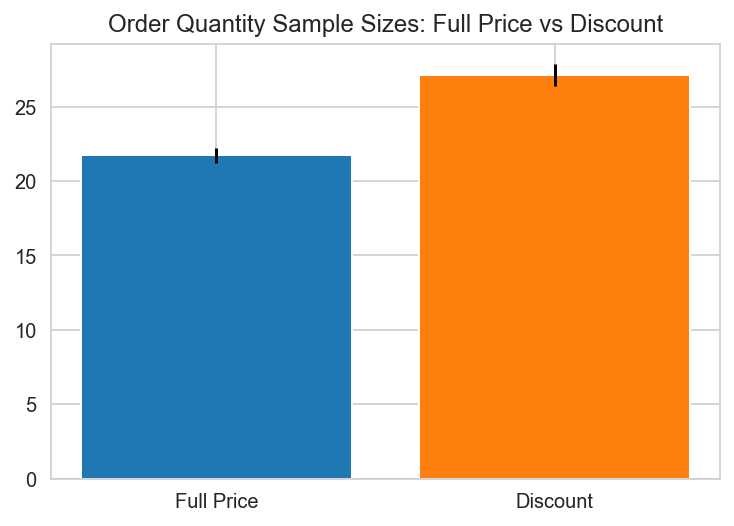
Normality Test
Check assumptions of normality and homogeneity of variance
# Test for normality - D'Agostino-Pearson's normality test: scipy.stats.normaltest
stat.normaltest(fullprice), stat.normaltest(discount)
(NormaltestResult(statistic=544.5770045551502, pvalue=5.579637380545965e-119),
NormaltestResult(statistic=261.528012299789, pvalue=1.6214878452829618e-57))
Failed normality test (p-values < 0.05). Run non-parametric test:
# Run non-parametric test (since normality test failed)
stat.mannwhitneyu(fullprice, discount)
MannwhitneyuResult(statistic=461541.0, pvalue=6.629381826999866e-11)
Statistical Test
Perform chosen statistical test.
# run tukey test for OQD (Order Quantity Discount)
data = df_orderDetail['Quantity'].values
labels = df_orderDetail['Discount'].values
import statsmodels.api as sms
model = sms.stats.multicomp.pairwise_tukeyhsd(data,labels)
# save OQD tukey test model results into dataframe (OQD: order quantity discount)
tukey_OQD = pd.DataFrame(data=model._results_table[1:], columns=model._results_table[0])
tukey_OQD
| group1 | group2 | meandiff | p-adj | lower | upper | reject | |
|---|---|---|---|---|---|---|---|
| 0 | 0.0 | 0.01 | -19.7153 | 0.9 | -80.3306 | 40.9001 | False |
| 1 | 0.0 | 0.02 | -19.7153 | 0.9 | -62.593 | 23.1625 | False |
| 2 | 0.0 | 0.03 | -20.0486 | 0.725 | -55.0714 | 14.9742 | False |
| 3 | 0.0 | 0.04 | -20.7153 | 0.9 | -81.3306 | 39.9001 | False |
| 4 | 0.0 | 0.05 | 6.2955 | 0.0011 | 1.5381 | 11.053 | True |
| 5 | 0.0 | 0.06 | -19.7153 | 0.9 | -80.3306 | 40.9001 | False |
| 6 | 0.0 | 0.1 | 3.5217 | 0.4269 | -1.3783 | 8.4217 | False |
| 7 | 0.0 | 0.15 | 6.6669 | 0.0014 | 1.551 | 11.7828 | True |
| 8 | 0.0 | 0.2 | 5.3096 | 0.0303 | 0.2508 | 10.3684 | True |
| 9 | 0.0 | 0.25 | 6.525 | 0.0023 | 1.3647 | 11.6852 | True |
| 10 | 0.01 | 0.02 | 0.0 | 0.9 | -74.2101 | 74.2101 | False |
| 11 | 0.01 | 0.03 | -0.3333 | 0.9 | -70.2993 | 69.6326 | False |
| 12 | 0.01 | 0.04 | -1.0 | 0.9 | -86.6905 | 84.6905 | False |
| 13 | 0.01 | 0.05 | 26.0108 | 0.9 | -34.745 | 86.7667 | False |
| 14 | 0.01 | 0.06 | 0.0 | 0.9 | -85.6905 | 85.6905 | False |
| 15 | 0.01 | 0.1 | 23.237 | 0.9 | -37.5302 | 84.0042 | False |
| 16 | 0.01 | 0.15 | 26.3822 | 0.9 | -34.4028 | 87.1671 | False |
| 17 | 0.01 | 0.2 | 25.0248 | 0.9 | -35.7554 | 85.805 | False |
| 18 | 0.01 | 0.25 | 26.2403 | 0.9 | -34.5485 | 87.029 | False |
| 19 | 0.02 | 0.03 | -0.3333 | 0.9 | -55.6463 | 54.9796 | False |
| 20 | 0.02 | 0.04 | -1.0 | 0.9 | -75.2101 | 73.2101 | False |
| 21 | 0.02 | 0.05 | 26.0108 | 0.6622 | -17.0654 | 69.087 | False |
| 22 | 0.02 | 0.06 | 0.0 | 0.9 | -74.2101 | 74.2101 | False |
| 23 | 0.02 | 0.1 | 23.237 | 0.7914 | -19.8552 | 66.3292 | False |
| 24 | 0.02 | 0.15 | 26.3822 | 0.6461 | -16.7351 | 69.4994 | False |
| 25 | 0.02 | 0.2 | 25.0248 | 0.7089 | -18.0857 | 68.1354 | False |
| 26 | 0.02 | 0.25 | 26.2403 | 0.6528 | -16.8823 | 69.3628 | False |
| 27 | 0.03 | 0.04 | -0.6667 | 0.9 | -70.6326 | 69.2993 | False |
| 28 | 0.03 | 0.05 | 26.3441 | 0.3639 | -8.9214 | 61.6096 | False |
| 29 | 0.03 | 0.06 | 0.3333 | 0.9 | -69.6326 | 70.2993 | False |
| 30 | 0.03 | 0.1 | 23.5703 | 0.5338 | -11.7147 | 58.8553 | False |
| 31 | 0.03 | 0.15 | 26.7155 | 0.3436 | -8.6001 | 62.0311 | False |
| 32 | 0.03 | 0.2 | 25.3582 | 0.428 | -9.9492 | 60.6656 | False |
| 33 | 0.03 | 0.25 | 26.5736 | 0.3525 | -8.7485 | 61.8957 | False |
| 34 | 0.04 | 0.05 | 27.0108 | 0.9 | -33.745 | 87.7667 | False |
| 35 | 0.04 | 0.06 | 1.0 | 0.9 | -84.6905 | 86.6905 | False |
| 36 | 0.04 | 0.1 | 24.237 | 0.9 | -36.5302 | 85.0042 | False |
| 37 | 0.04 | 0.15 | 27.3822 | 0.9 | -33.4028 | 88.1671 | False |
| 38 | 0.04 | 0.2 | 26.0248 | 0.9 | -34.7554 | 86.805 | False |
| 39 | 0.04 | 0.25 | 27.2403 | 0.9 | -33.5485 | 88.029 | False |
| 40 | 0.05 | 0.06 | -26.0108 | 0.9 | -86.7667 | 34.745 | False |
| 41 | 0.05 | 0.1 | -2.7738 | 0.9 | -9.1822 | 3.6346 | False |
| 42 | 0.05 | 0.15 | 0.3714 | 0.9 | -6.2036 | 6.9463 | False |
| 43 | 0.05 | 0.2 | -0.986 | 0.9 | -7.5166 | 5.5447 | False |
| 44 | 0.05 | 0.25 | 0.2294 | 0.9 | -6.3801 | 6.839 | False |
| 45 | 0.06 | 0.1 | 23.237 | 0.9 | -37.5302 | 84.0042 | False |
| 46 | 0.06 | 0.15 | 26.3822 | 0.9 | -34.4028 | 87.1671 | False |
| 47 | 0.06 | 0.2 | 25.0248 | 0.9 | -35.7554 | 85.805 | False |
| 48 | 0.06 | 0.25 | 26.2403 | 0.9 | -34.5485 | 87.029 | False |
| 49 | 0.1 | 0.15 | 3.1452 | 0.9 | -3.5337 | 9.824 | False |
| 50 | 0.1 | 0.2 | 1.7879 | 0.9 | -4.8474 | 8.4231 | False |
| 51 | 0.1 | 0.25 | 3.0033 | 0.9 | -3.7096 | 9.7161 | False |
| 52 | 0.15 | 0.2 | -1.3573 | 0.9 | -8.1536 | 5.4389 | False |
| 53 | 0.15 | 0.25 | -0.1419 | 0.9 | -7.014 | 6.7302 | False |
| 54 | 0.2 | 0.25 | 1.2154 | 0.9 | -5.6143 | 8.0451 | False |
# Plot a universal confidence interval of each group mean comparing significant differences in group means.
# Significant differences at the alpha=0.05 level can be identified by intervals that do not overlap
oq_data = df_orderDetail['Quantity'].values
discount_labels = df_orderDetail['Discount'].values
from statsmodels.stats.multicomp import MultiComparison
oqd = MultiComparison(oq_data, discount_labels)
results = oqd.tukeyhsd()
results.plot_simultaneous(comparison_name=0.05, xlabel='Order Quantity', ylabel='Discount Level');

Effect Size
Calculate effect size using Cohen’s D as well as any post-hoc tests.
#### Cohen's d
def Cohen_d(group1, group2):
# Compute Cohen's d.
# group1: Series or NumPy array
# group2: Series or NumPy array
# returns a floating point number
diff = group1.mean() - group2.mean()
n1, n2 = len(group1), len(group2)
var1 = group1.var()
var2 = group2.var()
# Calculate the pooled threshold as shown earlier
pooled_var = (n1 * var1 + n2 * var2) / (n1 + n2)
# Calculate Cohen's d statistic
d = diff / np.sqrt(pooled_var)
return d
Cohen_d(discount, fullprice)
0.2862724481729282
Post-hoc Tests
The mean quantity per order is similar for each of the discount levels that we identified as significant. The obvious conclusion to draw from this is that offering a discount higher than 5% does not increase the order quantities; higher discounts only produce higher loss in revenue.
# Extract revenue lost per discounted order where discount had no effect on order quantity
cur.execute("""SELECT Discount,
SUM(UnitPrice * Quantity) as 'revLoss',
COUNT(OrderId) as 'NumOrders'
FROM orderDetail
GROUP BY Discount
HAVING Discount != 0 AND Discount != 0.05
ORDER BY revLoss DESC;""")
df = pd.DataFrame(cur.fetchall())
df. columns = [i[0] for i in cur.description]
print(len(df))
df.head()
9
| Discount | revLoss | NumOrders | |
|---|---|---|---|
| 0 | 0.25 | 131918.09 | 154 |
| 1 | 0.20 | 111476.38 | 161 |
| 2 | 0.15 | 102948.44 | 157 |
| 3 | 0.10 | 101665.71 | 173 |
| 4 | 0.03 | 124.65 | 3 |
print("Total Revenue Forfeited $", df.revLoss.sum())
print("Number of Orders Affected ", df.NumOrders.sum())
print("Avg Forfeited Per Order $", df.revLoss.sum()/df.NumOrders.sum())
Total Revenue Forfeited $ 448373.27
Number of Orders Affected 653
Avg Forfeited Per Order $ 686.6359418070444
Analyze Results
Where alpha = 0.05, the null hypothesis is rejected. Discount amount has a statistically significant effect on the quantity in an order where the discount level is equal to 5%, 15%, 20% or 25%.
H2: Country–Discount
Do individual countries show a statistically significant preference for discount?
If so, which countries and to what extent?
Hypotheses
- $H_0$: Countries purchase equal quantities of discounted vs non-discounted products.
- $H_A$: Countries purchase different quantities of discounted vs non-discounted products.
EDA
Select the proper dataset for analysis, perform EDA, and generate data groups for testing.
Select
df_order = get_table(cur, "'Order'")
display(df_order.head())
display(df_orderDetail.head())
| OrderId | CustomerId | EmployeeId | OrderDate | RequiredDate | ShippedDate | ShipVia | Freight | ShipName | ShipAddress | ShipCity | ShipRegion | ShipPostalCode | ShipCountry | |
|---|---|---|---|---|---|---|---|---|---|---|---|---|---|---|
| 0 | 10248 | VINET | 5 | 2012-07-04 | 2012-08-01 | 2012-07-16 | 3 | 32.38 | Vins et alcools Chevalier | 59 rue de l'Abbaye | Reims | Western Europe | 51100 | France |
| 1 | 10249 | TOMSP | 6 | 2012-07-05 | 2012-08-16 | 2012-07-10 | 1 | 11.61 | Toms Spezialitäten | Luisenstr. 48 | Münster | Western Europe | 44087 | Germany |
| 2 | 10250 | HANAR | 4 | 2012-07-08 | 2012-08-05 | 2012-07-12 | 2 | 65.83 | Hanari Carnes | Rua do Paço, 67 | Rio de Janeiro | South America | 05454-876 | Brazil |
| 3 | 10251 | VICTE | 3 | 2012-07-08 | 2012-08-05 | 2012-07-15 | 1 | 41.34 | Victuailles en stock | 2, rue du Commerce | Lyon | Western Europe | 69004 | France |
| 4 | 10252 | SUPRD | 4 | 2012-07-09 | 2012-08-06 | 2012-07-11 | 2 | 51.30 | Suprêmes délices | Boulevard Tirou, 255 | Charleroi | Western Europe | B-6000 | Belgium |
| Id | OrderId | ProductId | UnitPrice | Quantity | Discount | discounted | |
|---|---|---|---|---|---|---|---|
| 0 | 10248/11 | 10248 | 11 | 14.0 | 12 | 0.0 | 0 |
| 1 | 10248/42 | 10248 | 42 | 9.8 | 10 | 0.0 | 0 |
| 2 | 10248/72 | 10248 | 72 | 34.8 | 5 | 0.0 | 0 |
| 3 | 10249/14 | 10249 | 14 | 18.6 | 9 | 0.0 | 0 |
| 4 | 10249/51 | 10249 | 51 | 42.4 | 40 | 0.0 | 0 |
# Rename 'Id' to 'OrderId' for joining tables with matching primary key name
df_order.rename({'Id':'OrderId'}, axis=1, inplace=True)
display(df_order.head())
| OrderId | CustomerId | EmployeeId | OrderDate | RequiredDate | ShippedDate | ShipVia | Freight | ShipName | ShipAddress | ShipCity | ShipRegion | ShipPostalCode | ShipCountry | |
|---|---|---|---|---|---|---|---|---|---|---|---|---|---|---|
| 0 | 10248 | VINET | 5 | 2012-07-04 | 2012-08-01 | 2012-07-16 | 3 | 32.38 | Vins et alcools Chevalier | 59 rue de l'Abbaye | Reims | Western Europe | 51100 | France |
| 1 | 10249 | TOMSP | 6 | 2012-07-05 | 2012-08-16 | 2012-07-10 | 1 | 11.61 | Toms Spezialitäten | Luisenstr. 48 | Münster | Western Europe | 44087 | Germany |
| 2 | 10250 | HANAR | 4 | 2012-07-08 | 2012-08-05 | 2012-07-12 | 2 | 65.83 | Hanari Carnes | Rua do Paço, 67 | Rio de Janeiro | South America | 05454-876 | Brazil |
| 3 | 10251 | VICTE | 3 | 2012-07-08 | 2012-08-05 | 2012-07-15 | 1 | 41.34 | Victuailles en stock | 2, rue du Commerce | Lyon | Western Europe | 69004 | France |
| 4 | 10252 | SUPRD | 4 | 2012-07-09 | 2012-08-06 | 2012-07-11 | 2 | 51.30 | Suprêmes délices | Boulevard Tirou, 255 | Charleroi | Western Europe | B-6000 | Belgium |
df_order.set_index('OrderId',inplace=True)
display(df_order.head())
| CustomerId | EmployeeId | OrderDate | RequiredDate | ShippedDate | ShipVia | Freight | ShipName | ShipAddress | ShipCity | ShipRegion | ShipPostalCode | ShipCountry | |
|---|---|---|---|---|---|---|---|---|---|---|---|---|---|
| OrderId | |||||||||||||
| 10248 | VINET | 5 | 2012-07-04 | 2012-08-01 | 2012-07-16 | 3 | 32.38 | Vins et alcools Chevalier | 59 rue de l'Abbaye | Reims | Western Europe | 51100 | France |
| 10249 | TOMSP | 6 | 2012-07-05 | 2012-08-16 | 2012-07-10 | 1 | 11.61 | Toms Spezialitäten | Luisenstr. 48 | Münster | Western Europe | 44087 | Germany |
| 10250 | HANAR | 4 | 2012-07-08 | 2012-08-05 | 2012-07-12 | 2 | 65.83 | Hanari Carnes | Rua do Paço, 67 | Rio de Janeiro | South America | 05454-876 | Brazil |
| 10251 | VICTE | 3 | 2012-07-08 | 2012-08-05 | 2012-07-15 | 1 | 41.34 | Victuailles en stock | 2, rue du Commerce | Lyon | Western Europe | 69004 | France |
| 10252 | SUPRD | 4 | 2012-07-09 | 2012-08-06 | 2012-07-11 | 2 | 51.30 | Suprêmes délices | Boulevard Tirou, 255 | Charleroi | Western Europe | B-6000 | Belgium |
df_country = df_orderDetail.merge(df_order, on='OrderId', copy=True)
Explore
fs.ft.alphasentaurii.hot_stats(df_country, 'ShipCountry')
-------->
HOT!STATS
<--------
SHIPCOUNTRY
Data Type: object
min Argentina
max Venezuela
Name: ShipCountry, dtype: object
à-la-Mode:
0 USA
dtype: object
No Nulls Found!
Non-Null Value Counts:
USA 352
Germany 328
Brazil 203
France 184
UK 135
Austria 125
Venezuela 118
Sweden 97
Canada 75
Mexico 72
Belgium 56
Ireland 55
Spain 54
Finland 54
Italy 53
Switzerland 52
Denmark 46
Argentina 34
Portugal 30
Poland 16
Norway 16
Name: ShipCountry, dtype: int64
# Unique Values: 21
Group
countries = df_country.groupby('ShipCountry').groups
countries.keys()
dict_keys(['Argentina', 'Austria', 'Belgium', 'Brazil', 'Canada', 'Denmark', 'Finland', 'France', 'Germany', 'Ireland', 'Italy', 'Mexico', 'Norway', 'Poland', 'Portugal', 'Spain', 'Sweden', 'Switzerland', 'UK', 'USA', 'Venezuela'])
df_countries = df_country[['ShipCountry','Quantity','discounted']].copy()
df_countries.ShipCountry.value_counts()
USA 352
Germany 328
Brazil 203
France 184
UK 135
Austria 125
Venezuela 118
Sweden 97
Canada 75
Mexico 72
Belgium 56
Ireland 55
Spain 54
Finland 54
Italy 53
Switzerland 52
Denmark 46
Argentina 34
Portugal 30
Poland 16
Norway 16
Name: ShipCountry, dtype: int64
import researchpy as rp
rp.summary_cont(df_countries.groupby(['discounted']))
| Quantity | ||||||
|---|---|---|---|---|---|---|
| N | Mean | SD | SE | 95% Conf. | Interval | |
| discounted | ||||||
| 0 | 1317 | 21.715262 | 17.507493 | 0.482426 | 20.769706 | 22.660818 |
| 1 | 838 | 27.109785 | 20.771439 | 0.717537 | 25.703412 | 28.516159 |
Test
Sample Size
# Check if sample sizes allow us to ignore assumptions;
# visualize sample size comparisons for two groups (normality check)
stat_dict = {}
for k,v in countries.items():
try:
grp0 = df_countries.loc[v].groupby('discounted').get_group(0)['Quantity']
grp1 = df_countries.loc[v].groupby('discounted').get_group(1)['Quantity']
print(f"{k}")
import scipy.stats as stat
plt.bar(x='Full Price', height=grp0.mean(), yerr=stat.sem(grp0))
plt.bar(x='Discounted', height=grp1.mean(), yerr=stat.sem(grp1))
plt.show()
except:
pass
try:
result = stat.ttest_ind(grp0,grp1)
if result[1] < 0.05:
stat_dict[k] = result[1]
print(f"\n{k} PREFERS DISCOUNTS!")
else:
continue
except:
print(f"{k} does not contain one of the groups.")
stat_dict
Argentina does not contain one of the groups.
Austria
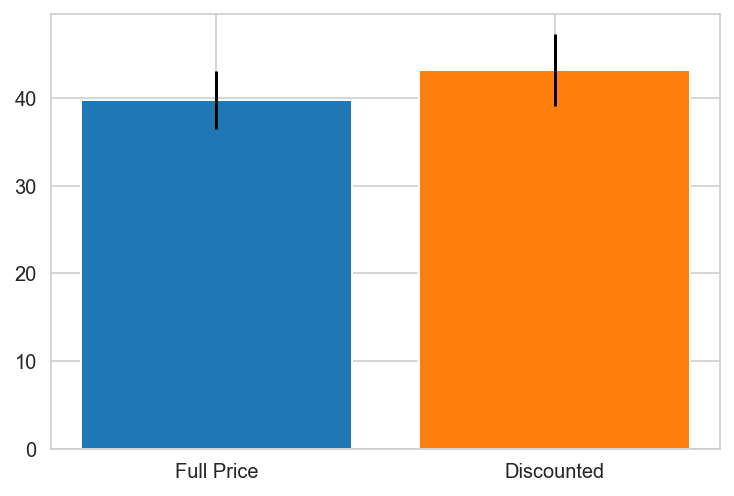
Belgium

Brazil
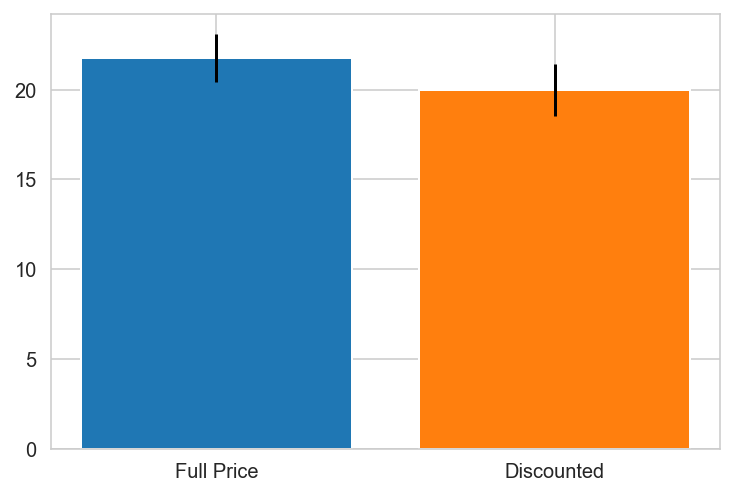
Canada
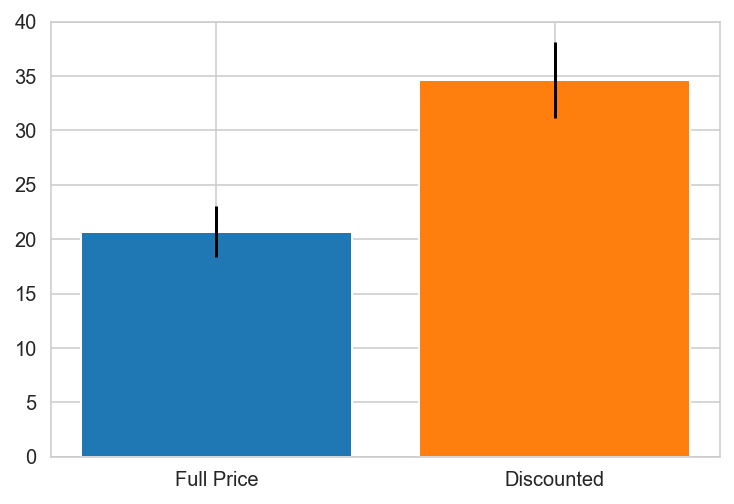
Canada PREFERS DISCOUNTS!
Denmark

Finland

France

Germany
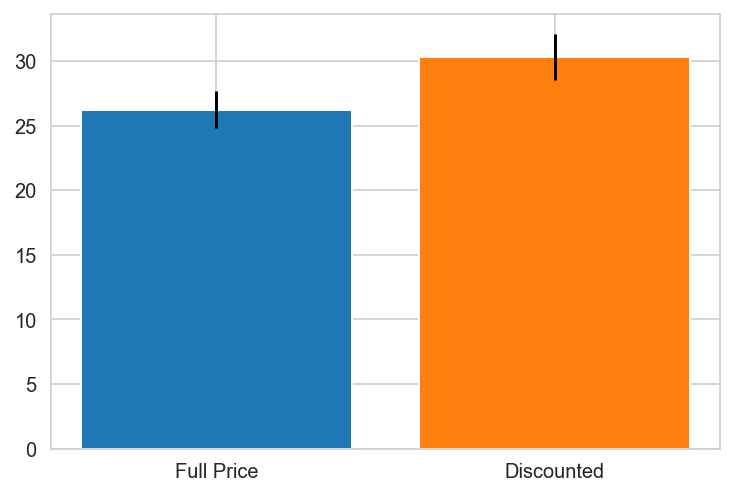
Ireland

Italy
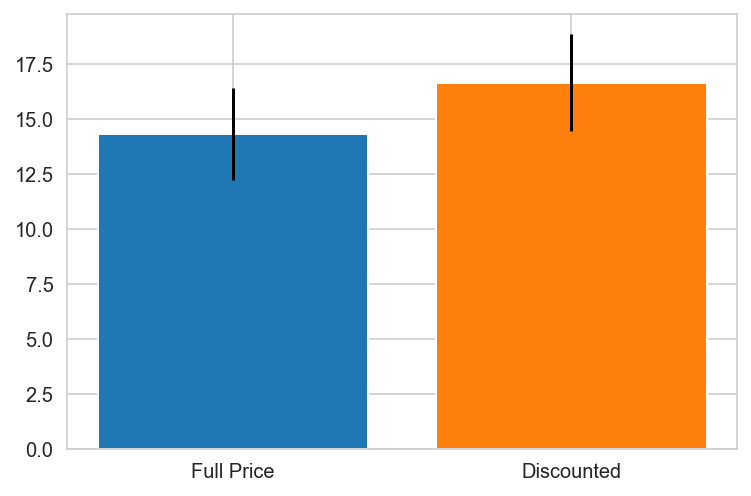
Mexico
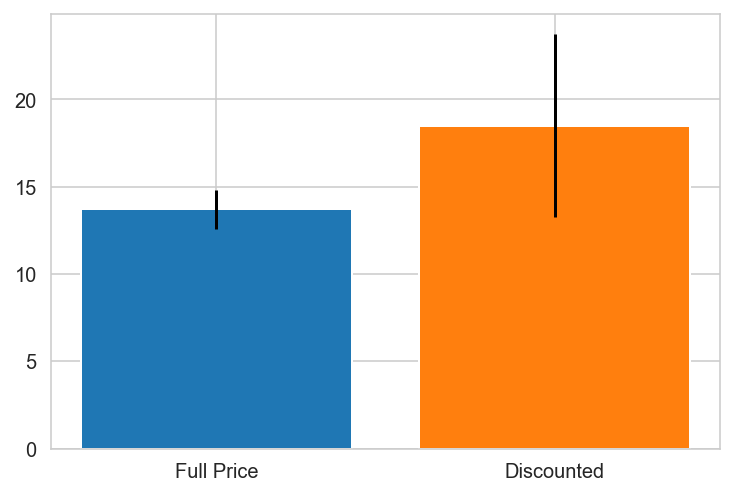
Norway PREFERS DISCOUNTS!
Portugal

Spain
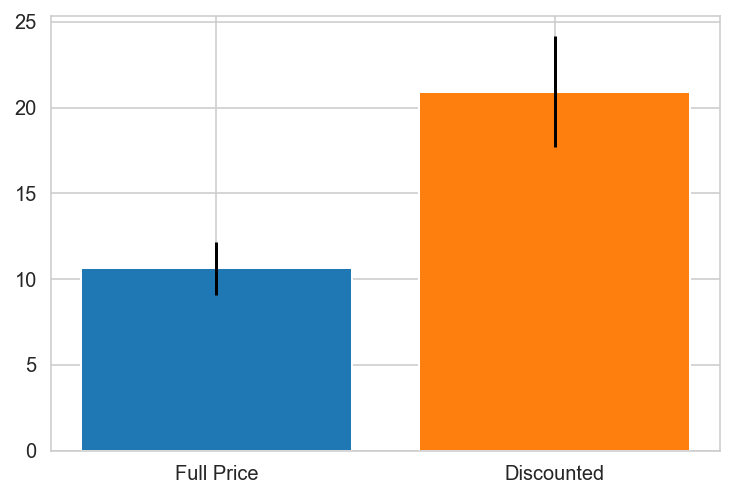
Spain PREFERS DISCOUNTS!
Sweden
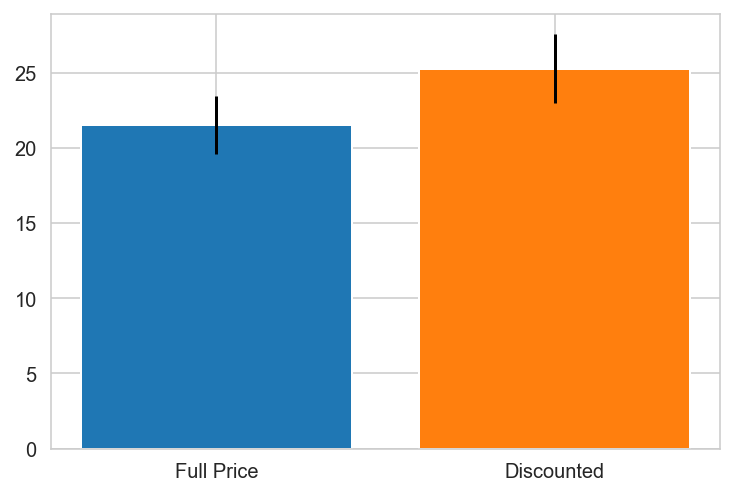
Switzerland

UK

UK PREFERS DISCOUNTS!
USA
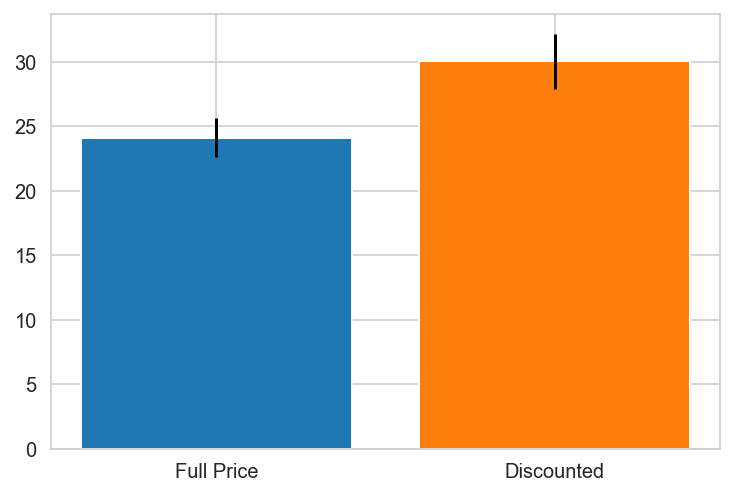
USA PREFERS DISCOUNTS!
Venezuela
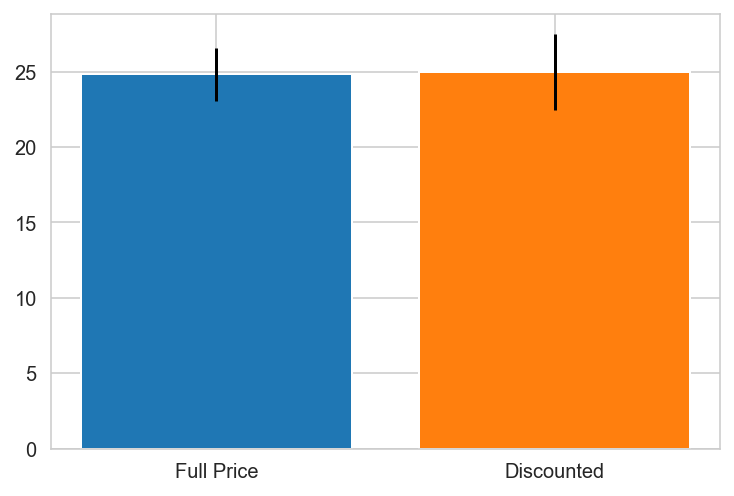
{'Canada': 0.0010297982736886485,
'Norway': 0.04480094051665529,
'Spain': 0.0025087181106716217,
'UK': 0.00031794803200322925,
'USA': 0.019868707223971476}
stat_dict
{'Canada': 0.0010297982736886485,
'Norway': 0.04480094051665529,
'Spain': 0.0025087181106716217,
'UK': 0.00031794803200322925,
'USA': 0.019868707223971476}
Normality Test
fig = plt.figure(figsize=(10,8))
ax = fig.gca(title="Distribution of Full price vs Discounted Orders")
sns.distplot(grp0)
sns.distplot(grp1)
ax.legend(['Full Price','Discounted'])
<matplotlib.legend.Legend at 0x1a25ab2978>

# Test for normality - D'Agostino-Pearson's normality test: scipy.stats.normaltest
stat.normaltest(grp0), stat.normaltest(grp1)
(NormaltestResult(statistic=9.316225653095811, pvalue=0.009484344125890621),
NormaltestResult(statistic=10.255309993341813, pvalue=0.005930451108115991))
# Run non-parametric test (since normality test failed)
stat.mannwhitneyu(grp0, grp1)
MannwhitneyuResult(statistic=1632.5, pvalue=0.44935140740973323)
Canada, Spain, UK and the USA have pvalues < 0.05 indicating there is a relationship between discount and order quantity and the null hypothesis is rejected for these individual countries.
Statistical Test
import statsmodels.api as sm
from statsmodels.formula.api import ols
model = ols("Quantity~C(discounted)+C(ShipCountry)+C(discounted):C(ShipCountry)", data=df_countries).fit()
anova_table = sm.stats.anova_lm(model, typ=2)
/Users/alphasentaurii/opt/anaconda3/envs/learn-env/lib/python3.6/site-packages/statsmodels/base/model.py:1752: ValueWarning: covariance of constraints does not have full rank. The number of constraints is 20, but rank is 18
'rank is %d' % (J, J_), ValueWarning)
/Users/alphasentaurii/opt/anaconda3/envs/learn-env/lib/python3.6/site-packages/statsmodels/base/model.py:1752: ValueWarning: covariance of constraints does not have full rank. The number of constraints is 20, but rank is 18
'rank is %d' % (J, J_), ValueWarning)
# reformat scientific notation of results for easier interpretation
anova_table.style.format("{:.5f}", subset=['PR(>F)'])
| sum_sq | df | F | PR(>F) | |
|---|---|---|---|---|
| C(discounted) | 9.78092e-08 | 1 | 3.07557e-10 | 0.99999 |
| C(ShipCountry) | 101347 | 20 | 15.9341 | 0.00000 |
| C(discounted):C(ShipCountry) | 15584.9 | 20 | 2.4503 | 0.00061 |
| Residual | 672930 | 2116 | nan | nan |
# calculate ttest_ind p-values and significance for individual countries
print(f"\n Countries with p-values < 0.05 - Null Hypothesis Rejected:")
for k,v in countries.items():
try:
grp0 = df_countries.loc[v].groupby('discounted').get_group(0)['Quantity']
grp1 = df_countries.loc[v].groupby('discounted').get_group(1)['Quantity']
result = stat.ttest_ind(grp0,grp1)
if result[1] < 0.05:
print(f"\n\t{k}: {result[1].round(4)}")
else:
continue
except:
None
Countries with p-values < 0.05 - Null Hypothesis Rejected:
Canada: 0.001
Spain: 0.0025
UK: 0.0003
USA: 0.0199
Although discount does not have a significant effect on countries overall (p = 0.99), there is a statistically significant relationship between order quantities and discount in some of the countries (p=0.0006).
Countries with p-values < 0.05 - Null Hypothesis Rejected:
Canada: 0.001
Spain: 0.0025
UK: 0.0003
USA: 0.0199
y1 = df_countries.groupby('discounted').get_group(1)['Quantity']
fig = plt.figure(figsize=(18,12))
ax = fig.gca()
ax = sns.barplot(x='ShipCountry', y=y1, data=df_countries)
ax.set_title('Average Discount Order Quantity by Country', fontdict={'family': 'PT Mono', 'size':16})
Text(0.5, 1.0, 'Average Discount Order Quantity by Country')
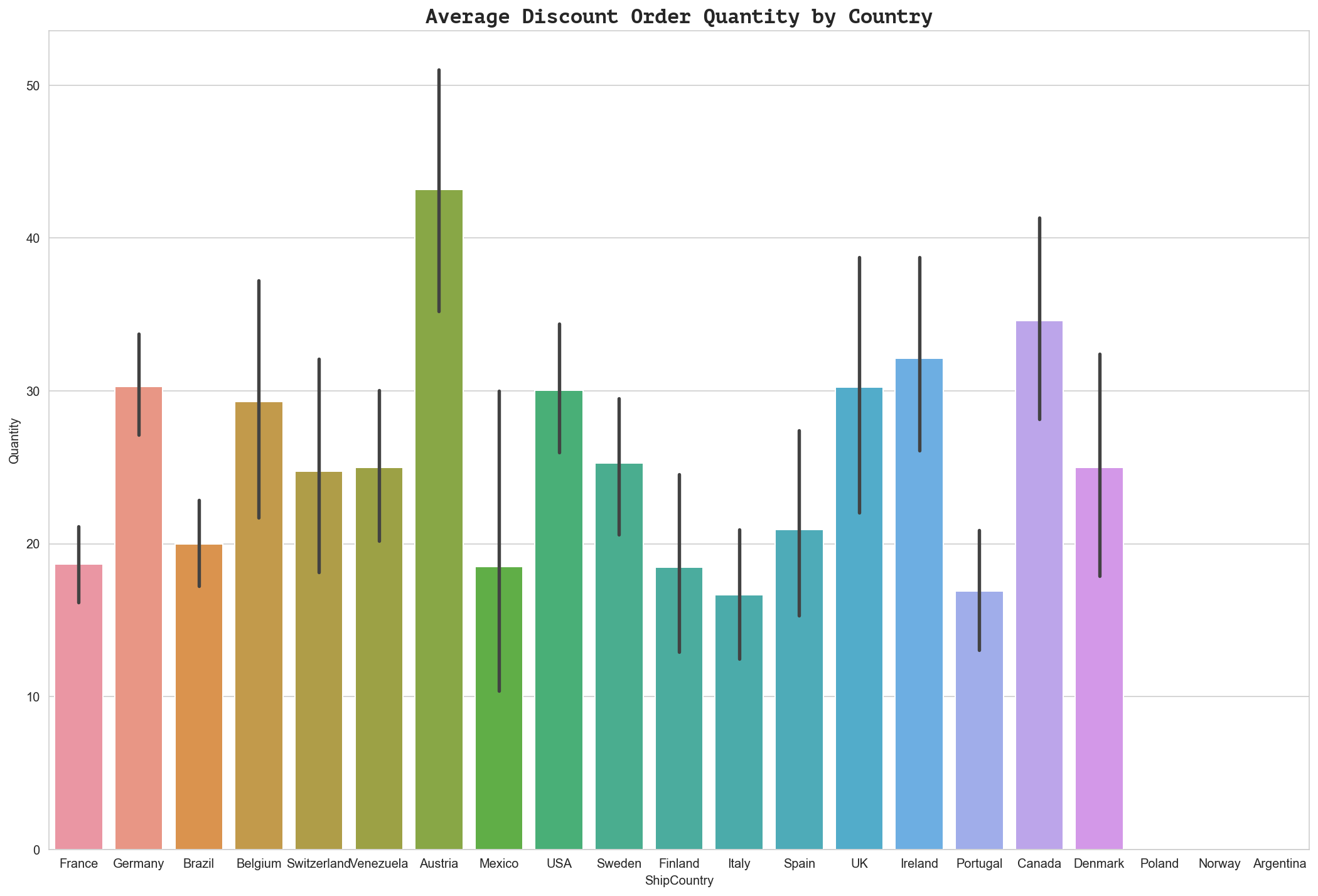
Effect Size
Effect size testing is unnecessary since the null hypothesis for the main question was not rejected.
Post-hoc Tests
#!pip install pandasql
from pandasql import sqldf
pysqldf = lambda q: sqldf(q, globals())
# Compare number of discount vs fullprice orders by country.
# Create bar plots grouped as discount vs fullprice orders by country
#fig, axes = plt.subplots(nrows=1, ncols=1, figsize=(18,8))
q1 = "SELECT ShipCountry, AVG(Quantity) as OrderQty from df_countries where discounted = 0 group by 1;"
q2 = "SELECT ShipCountry, AVG(Quantity) as OrderQty from df_countries where discounted = 1 group by 1;"
df_fpCount = pysqldf(q1)
df_dcCount = pysqldf(q2)
df_fpCount['Group'] = 'FullPrice'
df_dcCount['Group'] = 'Discount'
df_country_qty = pd.concat([df_fpCount, df_dcCount], axis=0)
display(df_country_qty.describe())
#ax = sns.barplot(x='ShipCountry', y='NumOrders', data=country_df, hue='Group', palette='pastel', orient='v')
#ax.set_title('Number of Fullprice vs Discount Orders by Country', fontdict={'family': 'monospace', 'size':16})
#ax1 = sns.barplot(x='ShipCountry', y='TotalQty', data=country_df, hue='Group', palette='pastel', orient='v')
#ax1.set_title('Total Qty of Fullprice vs Discount Orders by Country', fontdict={'family': 'monospace', 'size':16})
sns.set_style("whitegrid")
fig = plt.figure(figsize=(18,8))
ax = fig.gca(title="Average Order Quantity by Country: Fullprice vs Discount")
sns.barplot(x='ShipCountry', y='OrderQty', ax=ax, data=df_country_qty, hue='Group',
palette='pastel', orient='v', ci=68, capsize=.2)
## Set Title,X/Y Labels,fonts,formatting
ax_font = {'family':'monospace','weight':'semibold','size':14}
tick_font = {'size':12,'ha':'center','rotation':45}
t_label = "Average Order Quantity by Country: Fullprice vs Discount Orders"
t_font = {'family': 'PT Mono', 'size':18}
ax.set_ylabel("Order Qty", fontdict=ax_font)
ax.set_xlabel("Country", fontdict=ax_font)
#ax.set_title('Average Order Quantity by Country: Fullprice vs Discount', fontdict={'family': 'PT Mono', 'size':16})
ax.set_title(t_label, fontdict=t_font)
| OrderQty | |
|---|---|
| count | 39.000000 |
| mean | 22.596281 |
| std | 7.620086 |
| min | 9.970588 |
| 25% | 17.458458 |
| 50% | 21.750000 |
| 75% | 25.985539 |
| max | 43.172414 |
Text(0.5, 1.0, 'Average Order Quantity by Country: Fullprice vs Discount Orders')
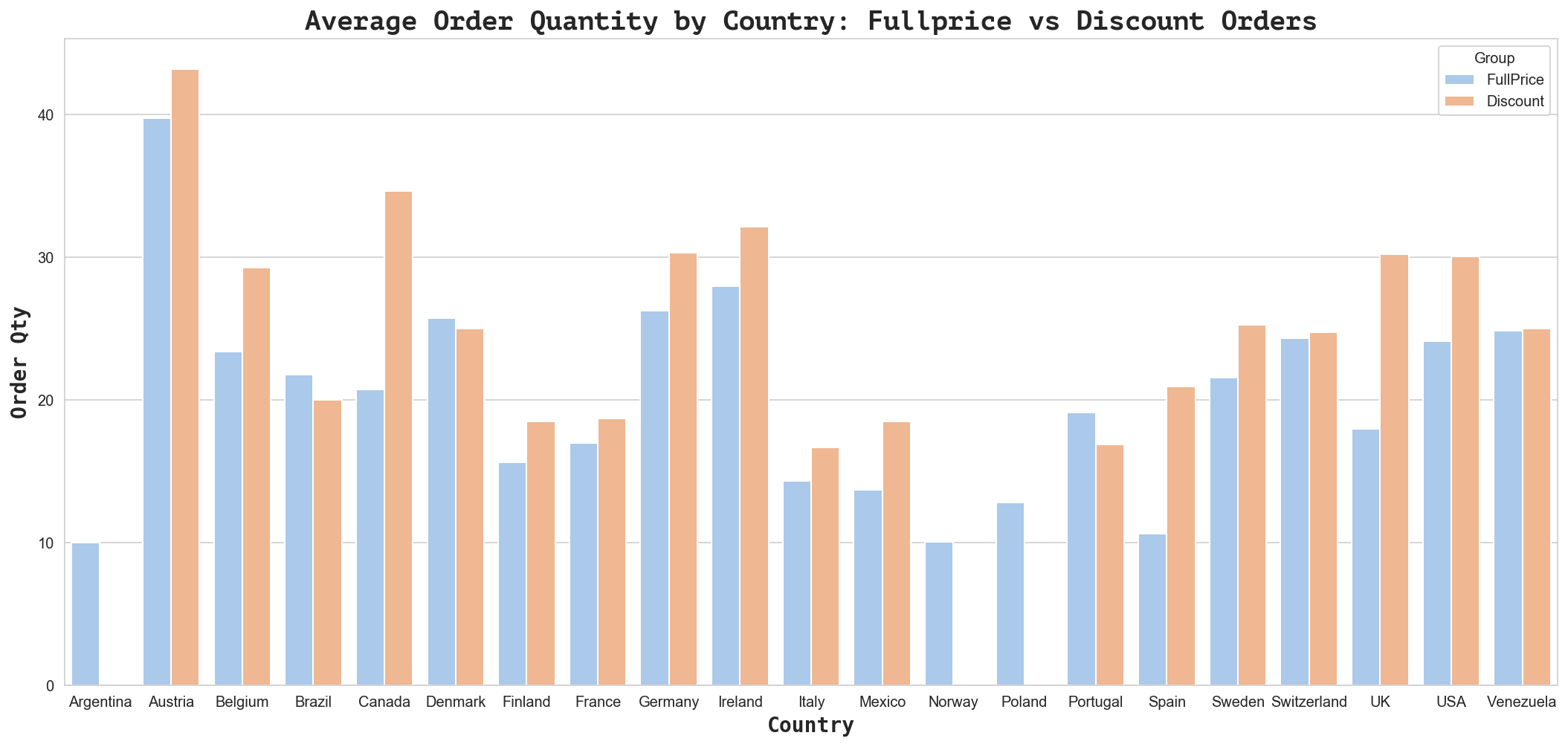
According to the plot above, the actual number of discounted orders is lower than the number of full price orders. Let’s compare the sum of quantities for these orders in each group.
# Compare number of discount vs fullprice orders by country.
# Create bar plots grouped as discount vs fullprice orders by country
#fig, axes = plt.subplots(nrows=1, ncols=1, figsize=(18,8))
q1 = "SELECT ShipCountry, Count(*) as OrderCount from df_countries where discounted = 0 group by 1;"
q2 = "SELECT ShipCountry, Count(*) as OrderCount from df_countries where discounted = 1 group by 1;"
df_fpCount = pysqldf(q1)
df_dcCount = pysqldf(q2)
df_fpCount['Group'] = 'FullPrice'
df_dcCount['Group'] = 'Discount'
df_country_count = pd.concat([df_fpCount, df_dcCount], axis=0)
display(df_country_count.describe())
#ax = sns.barplot(x='ShipCountry', y='NumOrders', data=country_df, hue='Group', palette='pastel', orient='v')
#ax.set_title('Number of Fullprice vs Discount Orders by Country', fontdict={'family': 'monospace', 'size':16})
#ax1 = sns.barplot(x='ShipCountry', y='TotalQty', data=country_df, hue='Group', palette='pastel', orient='v')
#ax1.set_title('Total Qty of Fullprice vs Discount Orders by Country', fontdict={'family': 'monospace', 'size':16})
fig = plt.figure(figsize=(18,8))
ax = fig.gca(title="Mean QPO by Country")
sns.barplot(x='ShipCountry', y='OrderCount', ax=ax, data=df_country_count, hue='Group', palette='Reds_d',
orient='v', ci=68, capsize=.2)
## Set Title,X/Y Labels,fonts,formatting
ax_font = {'family':'monospace','weight':'semibold','size':14}
tick_font = {'size':12,'ha':'center','rotation':45}
t_label = "Count of Fullprice vs Discount Orders by Country"
t_font = {'family': 'PT Mono', 'size':18}
ax.set_ylabel("Number of Orders", fontdict=ax_font)
ax.set_xlabel("Country", fontdict=ax_font)
#ax.set_title('Average Order Quantity by Country: Fullprice vs Discount', fontdict={'family': 'PT Mono', 'size':16})
ax.set_title(t_label, fontdict=t_font)
| OrderCount | |
|---|---|
| count | 39.000000 |
| mean | 55.256410 |
| std | 48.722478 |
| min | 8.000000 |
| 25% | 22.000000 |
| 50% | 39.000000 |
| 75% | 69.500000 |
| max | 210.000000 |
Text(0.5, 1.0, 'Count of Fullprice vs Discount Orders by Country')

This still doesn’t tell us much about whether or not these countries prefer discounts (tend to order more products) or not - in order to get better insight, we need to look at the average order size (mean quantities per order) for each group.
# Compare number of discount vs fullprice orders by country.
# Create bar plots grouped as discount vs fullprice orders by country
#fig, axes = plt.subplots(nrows=1, ncols=1, figsize=(18,8))
#q1 = "SELECT ShipCountry, Count(*) as NumOrders, SUM(Quantity) as TotalQty, AVG(Quantity) as MeanQPO from df_countries where discounted = 0 group by 1;"
#q2 = "SELECT ShipCountry, Count(*) as NumOrders, SUM(Quantity) as TotalQty, AVG(Quantity) as MeanQPO from df_countries where discounted = 1 group by 1;"
q1 = "SELECT ShipCountry, AVG(Quantity) as MeanQPO from df_countries where discounted = 0 group by 1;"
q2 = "SELECT ShipCountry, AVG(Quantity) as MeanQPO from df_countries where discounted = 1 group by 1;"
fullprice_df = pysqldf(q1)
discount_df = pysqldf(q2)
fullprice_df['Group'] = 'FullPrice'
discount_df['Group'] = 'Discount'
country_df = pd.concat([fullprice_df, discount_df], axis=0)
display(country_df.describe())
#ax = sns.barplot(x='ShipCountry', y='NumOrders', data=country_df, hue='Group', palette='pastel', orient='v')
#ax.set_title('Number of Fullprice vs Discount Orders by Country', fontdict={'family': 'monospace', 'size':16})
#ax1 = sns.barplot(x='ShipCountry', y='TotalQty', data=country_df, hue='Group', palette='pastel', orient='v')
#ax1.set_title('Total Qty of Fullprice vs Discount Orders by Country', fontdict={'family': 'monospace', 'size':16})
fig = plt.figure(figsize=(18,8))
ax = fig.gca(title="Mean QPO by Country")
sns.barplot(x='ShipCountry', y='MeanQPO', ax=ax, data=country_df, hue='Group', palette='Greens_d',
orient='v', capsize=.2)
## Set Title,X/Y Labels,fonts,formatting
ax_font = {'family':'monospace','weight':'semibold','size':14}
tick_font = {'size':12,'ha':'center','rotation':45}
t_label = "Average Order Quantity by Country: Fullprice vs Discount"
t_font = {'family': 'PT Mono', 'size':18}
ax.set_ylabel("Avg Qty per Order ", fontdict=ax_font)
ax.set_xlabel("Country", fontdict=ax_font)
#ax.set_title('Average Order Quantity by Country: Fullprice vs Discount', fontdict={'family': 'PT Mono', 'size':16})
ax.set_title(t_label, fontdict=t_font)
| MeanQPO | |
|---|---|
| count | 39.000000 |
| mean | 22.596281 |
| std | 7.620086 |
| min | 9.970588 |
| 25% | 17.458458 |
| 50% | 21.750000 |
| 75% | 25.985539 |
| max | 43.172414 |
Text(0.5, 1.0, 'Average Order Quantity by Country: Fullprice vs Discount')

The above plots indicate that when a discount is offered, certain countries order higher quantities of products. Let’s look at the values to determine what percentage more they purchase when an order is discounted.
# add new col for countries where discount has significant effect
fig = plt.figure(figsize=(18,12))
ax = fig.gca()
df_countries['effect_cqd'] = df_countries['ShipCountry'].isin(['Spain', 'UK', 'USA', 'Canada'])
ax = sns.barplot(x='ShipCountry', y='Quantity', hue='effect_cqd', palette='pastel', data=df_countries)
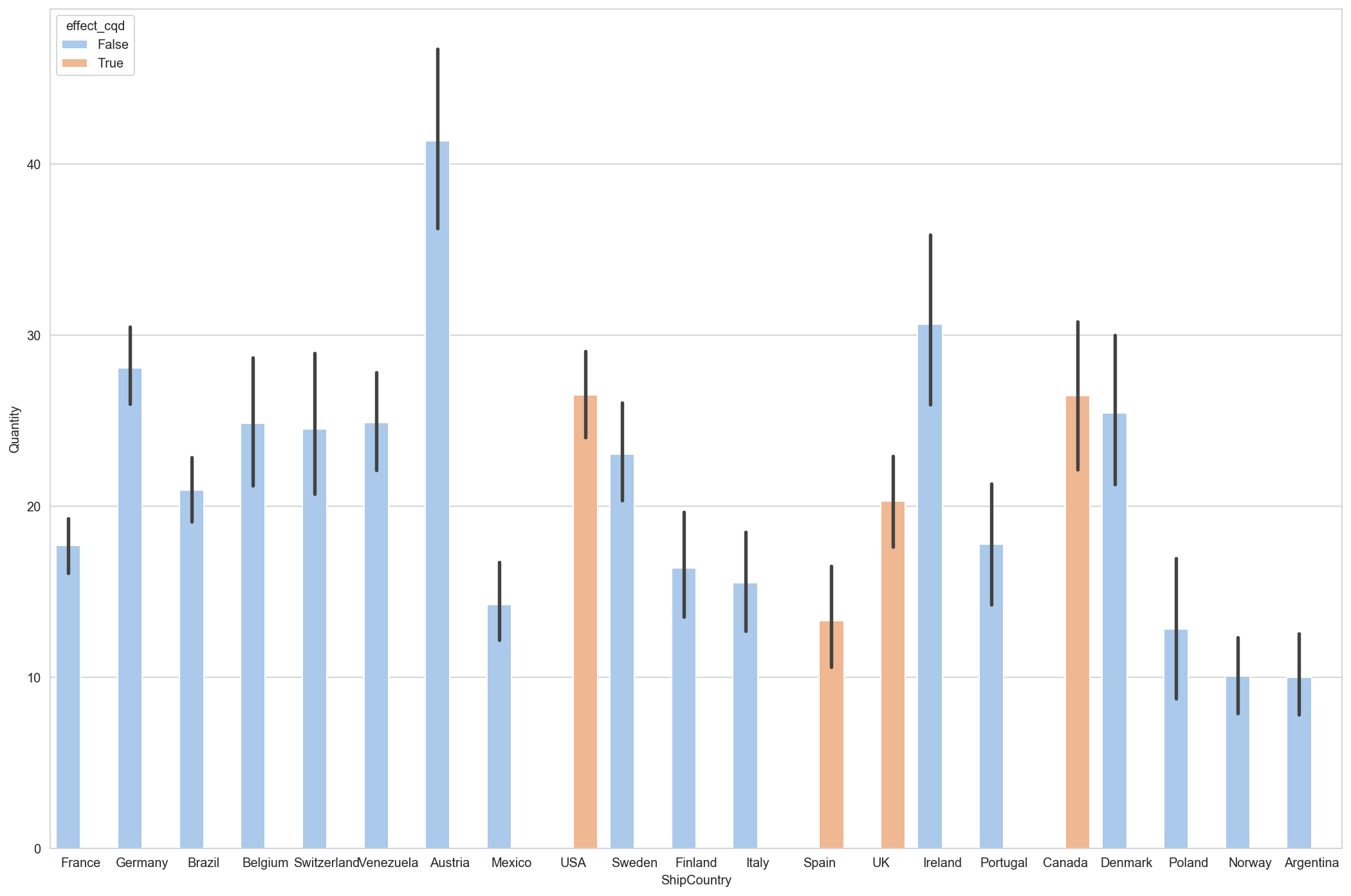
q1 = "SELECT ShipCountry, Count(*) as OrderCount from df_countries where discounted = 0 group by 1;"
q2 = "SELECT ShipCountry, Count(*) as OrderCount from df_countries where discounted = 1 group by 1;"
df_fpCount = pysqldf(q1)
df_dcCount = pysqldf(q2)
df_fpCount['Group'] = 'FullPrice'
df_dcCount['Group'] = 'Discount'
df_countryCount = pd.concat([df_fpCount, df_dcCount])
fig = plt.figure(figsize=(18,8))
ax = fig.gca(title="Average Order Quantity by Country")
ax = sns.barplot(x='ShipCountry', y='OrderCount', data=df_countryCount)
ax.set_title('Order Count by Country', fontdict={'family': 'PT Mono', 'size':16})
Text(0.5, 1.0, 'Order Count by Country')

Results
For certain individual countries (Spain, Canada, UK, USA), the null hypothesis is rejected with 95% certainty (alpha=0.05)
H3: Region & Revenue
Does average revenue per order vary between different customer regions?
If so, how do the regions rank in terms of average revenue per order?
Additional questions to explore: Does geographic distance between distributor and shipcountry have an effect on order quantity? Does shipping cost have an effect on order quantity?
Hypotheses
$H_0$ the average revenue per order is the same between different customer regions.
$H_1$ Alternate hypothesis: the average revenue per order is different (higher or lower) across different customer regions.
The alpha level (i.e. the probability of rejecting the null hypothesis when it is true) is = 0.05.
EDA
Select the proper dataset for analysis, generate data groups for testing, perform EDA.
Select
# Extract revenue per product per order
cur.execute("""SELECT c.Region, od.OrderId, od.Quantity, od.UnitPrice, od.Discount
FROM Customer c
JOIN 'Order' o ON c.Id = o.CustomerId
JOIN OrderDetail od USING(OrderId);""")
df = pd.DataFrame(cur.fetchall())
df. columns = [i[0] for i in cur.description]
print(len(df))
df.head()
2078
| Region | OrderId | Quantity | UnitPrice | Discount | |
|---|---|---|---|---|---|
| 0 | Western Europe | 10248 | 12 | 14.0 | 0.0 |
| 1 | Western Europe | 10248 | 10 | 9.8 | 0.0 |
| 2 | Western Europe | 10248 | 5 | 34.8 | 0.0 |
| 3 | Western Europe | 10249 | 9 | 18.6 | 0.0 |
| 4 | Western Europe | 10249 | 40 | 42.4 | 0.0 |
# Get total revenue per order
df['Revenue'] = df.Quantity * df.UnitPrice * (1-df.Discount)
# Drop unnecessary columns
df.drop(['Quantity', 'UnitPrice', 'Discount'], axis=1, inplace=True)
Group
# Group data by order and get average revenue per order for each region
df_region = df.groupby(['Region', 'OrderId'])['Revenue'].mean().reset_index()
# drop Order Id (no longer necessary)
df_region.drop('OrderId', axis=1, inplace=True)
# check changes
df_region.head()
| Region | Revenue | |
|---|---|---|
| 0 | British Isles | 239.70 |
| 1 | British Isles | 661.25 |
| 2 | British Isles | 352.40 |
| 3 | British Isles | 258.40 |
| 4 | British Isles | 120.20 |
# Explore sample sizes before testing: n > 30 to pass assumptions
df_region.groupby('Region').count()
| Revenue | |
|---|---|
| Region | |
| British Isles | 75 |
| Central America | 21 |
| Eastern Europe | 7 |
| North America | 152 |
| Northern Europe | 55 |
| Scandinavia | 28 |
| South America | 127 |
| Southern Europe | 64 |
| Western Europe | 272 |
Some of the sample sizes are too small to ignore assumptions of normality. We can combine some regions to meet the required threshold of n > 30.
# Group sub-regions together to create sample sizes adequately large for ANOVA testing (min 30)
# Group Scandinavia, Northern and Eastern Europe
df_region.loc[(df_region.Region == 'Scandinavia') | (df_region.Region == 'Eastern Europe') | (df_region.Region == 'Northern Europe'), 'Region'] = 'North Europe'
# Group South and Central America
df_region.loc[(df_region.Region == 'South America') | (df_region.Region == 'Central America'), 'Region'] = 'South Americas'
# Review sizes of new groups
df_region.groupby('Region').count()
| Revenue | |
|---|---|
| Region | |
| British Isles | 75 |
| North America | 152 |
| North Europe | 90 |
| South Americas | 148 |
| Southern Europe | 64 |
| Western Europe | 272 |
Explore
fig = plt.figure(figsize=(10,8))
ax = fig.gca()
sns.distplot(grp0)
sns.distplot(grp1)
ax.legend(['Full Price','Discounted'])
# Plot number of orders, total revenue, and average revenue per order by region
fig, (ax1, ax2, ax3) = plt.subplots(3, 1, figsize=(8,8))
# Number of orders
df_region.groupby(['Region'])['Revenue'].count().plot(kind='barh', ax=ax1, color='b')
# Total Revenue
df_region.groupby(['Region'])['Revenue'].sum().plot(kind='barh', ax=ax2, color='r')
# Average Revenue
df_region.groupby(['Region'])['Revenue'].mean().plot(kind='barh', ax=ax3, color='g')
# Label plots and axes
ax1.set_title('Total Orders')
ax1.set_ylabel('')
ax2.set_title('Total Revenue in US$')
ax2.set_ylabel('')
ax3.set_title('Average Revenue per Order US$')
ax3.set_ylabel('')
fig.subplots_adjust(hspace=0.4);
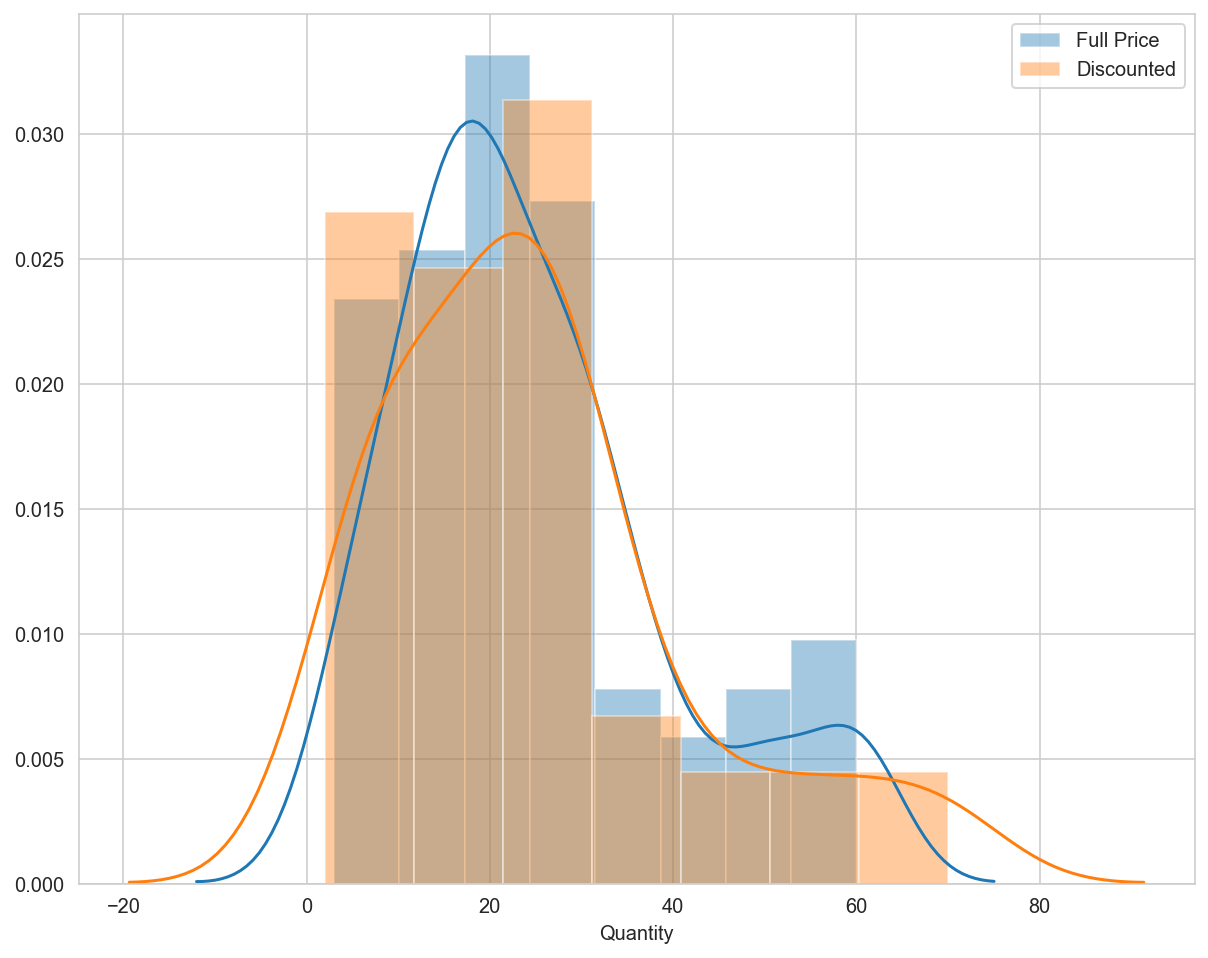
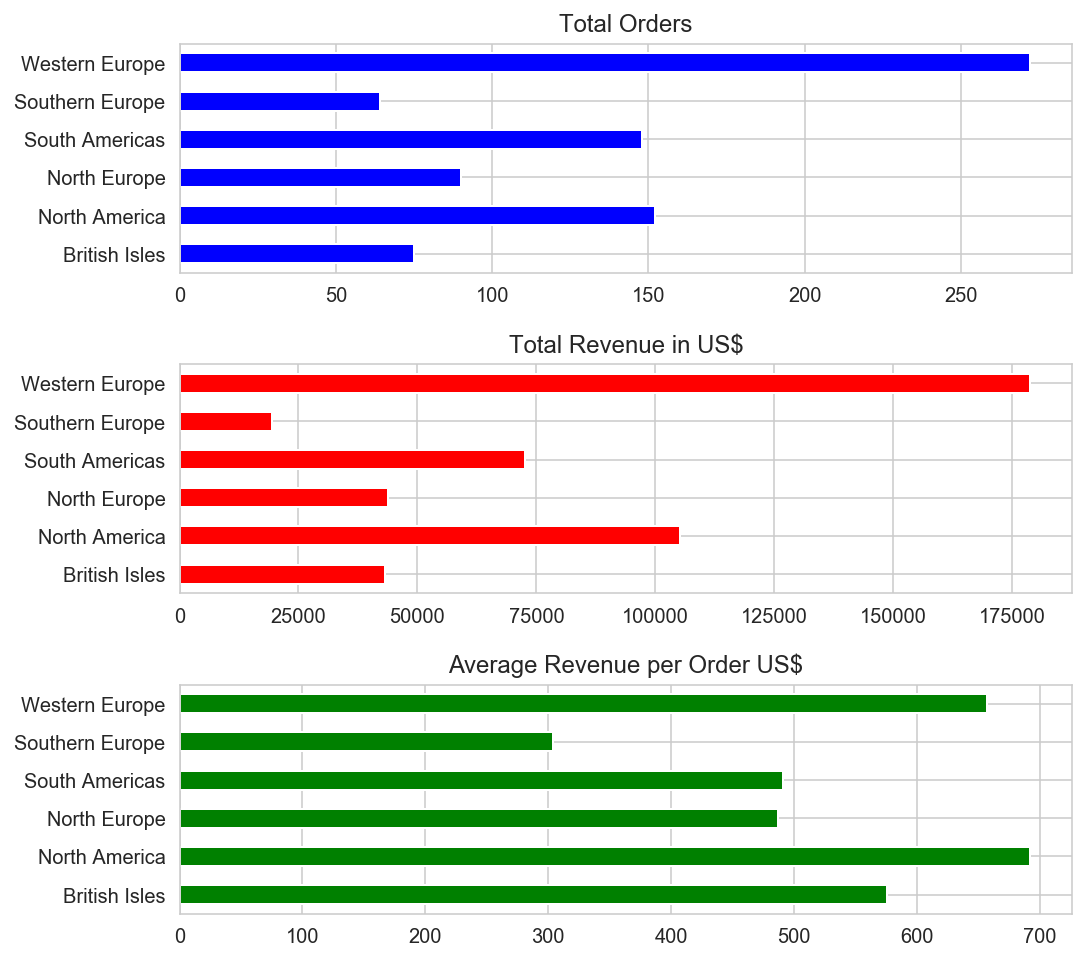
The graphs show that Western Europe is the region with the greatest number of orders, and also has the greatest total revenue. However, North America has the most expensive order on average (followed by Western Europe). Southern and Eastern Europe has the lowest number of orders, lowest total revenue, and cheapest order on average. The third graph lent support to the alternate hypothesis that there are significant differences in average order revenue between regions.
Test
Sample Size
Check if sample sizes allow us to ignore assumptions of normality
# visualize sample size comparisons, check normality (pvals)
fig = plt.figure(figsize=(12,6))
ax = fig.gca()
ax = sns.barplot(x='Region', y='Revenue', data=df_region, ci=68, palette="pastel", hue='Region')
ax.set_title('Average Order Revenue by Region', fontdict={'family': 'PT Mono', 'size':16})
Text(0.5, 1.0, 'Average Order Revenue by Region')
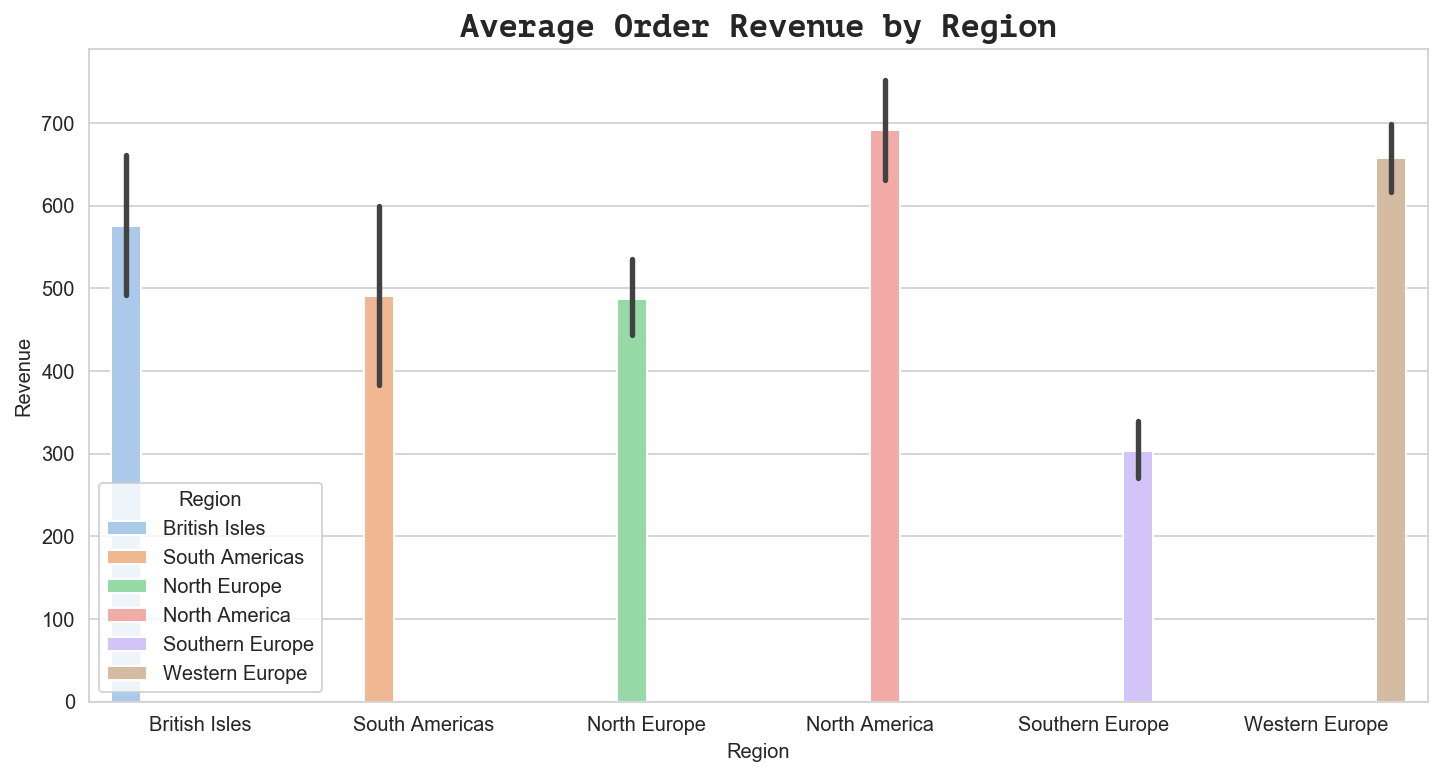
Normality
Statistical
import statsmodels.api as sm
from statsmodels.formula.api import ols
model = ols("Revenue~C(Region)+Revenue:C(Region)", data=df_region).fit()
anova_table = sm.stats.anova_lm(model, typ=2)
# reformat scientific notation of results for easier interpretation
anova_table.style.format("{:.5f}", subset=['PR(>F)'])
| sum_sq | df | F | PR(>F) | |
|---|---|---|---|---|
| C(Region) | 1.03486e+07 | 5 | 3.98262e+30 | 0.00000 |
| Revenue:C(Region) | 5.34162e+08 | 6 | 1.71309e+32 | 0.00000 |
| Residual | 4.10034e-22 | 789 | nan | nan |
# run tukey test for OQD (Order Quantity Discount)
data = df_region['Revenue'].values
labels = df_region['Region'].values
import statsmodels.api as sms
model = sms.stats.multicomp.pairwise_tukeyhsd(data,labels)
# save OQD tukey test model results into dataframe (OQD: order quantity discount)
tukey_OQD = pd.DataFrame(data=model._results_table[1:], columns=model._results_table[0])
tukey_OQD
| group1 | group2 | meandiff | p-adj | lower | upper | reject | |
|---|---|---|---|---|---|---|---|
| 0 | British Isles | North America | 116.4615 | 0.9 | -213.9625 | 446.8854 | False |
| 1 | British Isles | North Europe | -88.1693 | 0.9 | -454.2704 | 277.9318 | False |
| 2 | British Isles | South Americas | -84.2501 | 0.9 | -416.146 | 247.6458 | False |
| 3 | British Isles | Southern Europe | -271.7815 | 0.3745 | -670.2535 | 126.6904 | False |
| 4 | British Isles | Western Europe | 81.6889 | 0.9 | -223.7052 | 387.083 | False |
| 5 | North America | North Europe | -204.6308 | 0.4191 | -516.0716 | 106.8101 | False |
| 6 | North America | South Americas | -200.7115 | 0.2778 | -471.1191 | 69.6961 | False |
| 7 | North America | Southern Europe | -388.243 | 0.0191 | -737.1631 | -39.3228 | True |
| 8 | North America | Western Europe | -34.7725 | 0.9 | -271.9032 | 202.3581 | False |
| 9 | North Europe | South Americas | 3.9193 | 0.9 | -309.0829 | 316.9214 | False |
| 10 | North Europe | Southern Europe | -183.6122 | 0.7177 | -566.4899 | 199.2655 | False |
| 11 | North Europe | Western Europe | 169.8582 | 0.5251 | -114.889 | 454.6055 | False |
| 12 | South Americas | Southern Europe | -187.5315 | 0.6259 | -537.8459 | 162.783 | False |
| 13 | South Americas | Western Europe | 165.939 | 0.3541 | -73.2385 | 405.1164 | False |
| 14 | Southern Europe | Western Europe | 353.4704 | 0.0242 | 28.1539 | 678.787 | True |
North America and Southern Europe: pval = 0.01, mean diff: -388.24
Southern Europe and Western Europe: pval = 0.02, mean diff: 353.4704
Effect Size
Cohen’s D
northamerica = df_region.loc[df_region['Region'] == 'North America']
southerneurope = df_region.loc[df_region['Region'] == 'Southern Europe']
westerneurope = df_region.loc[df_region['Region'] == 'Western Europe']
na_se = Cohen_d(northamerica.Revenue, southerneurope.Revenue)
se_we = Cohen_d(southerneurope.Revenue, westerneurope.Revenue)
print(na_se, se_we)
0.5891669383438923 -0.5462384714677272
Post-Hoc Tests
# log-transforming revenue per order
logRegion_df = df_region.copy()
logRegion_df['Revenue'] = np.log(df_region['Revenue'])
# Plotting the distributions for the log-transformed data
sns.set_style("whitegrid")
fig = plt.figure(figsize=(12,8))
ax = fig.gca(title="Distribution of Revenue Per Order by Region")
for region in set(logRegion_df.Region):
region_group = logRegion_df.loc[logRegion_df['Region'] == region]
sns.distplot(region_group['Revenue'], hist_kws=dict(alpha=0.5), label=region)
ax.legend()
ax.set_label('Revenue per Order (log-transformed)')

# The data is more normally distributed, and variances from the mean were more similar.
# run an ANOVA test:
# Fitting a model of revenue per order on Region categories - ANOVA table
lm = ols('Revenue ~ C(Region)', logRegion_df).fit()
sm.stats.anova_lm(lm, typ=2)
| sum_sq | df | F | PR(>F) | |
|---|---|---|---|---|
| C(Region) | 48.004167 | 5.0 | 12.076998 | 2.713885e-11 |
| Residual | 631.999979 | 795.0 | NaN | NaN |
Results
At an alpha level of 0.05 significance, revenue does vary between regions and therefore the null hypothesis is rejected.
The ANOVA table above revealed that the p-value is lower than the alpha value of 0.05. Therefore I was able to reject the null hypothesis and accept the alternate hypothesis. There are statistically significant differences in average order value between different regions, i.e. customers from different parts of the world spend different amounts of money on their orders, on average. Conclusions Business insights: There are statistically significant differences in the average revenue per order from customers from different regions. Western European customers place the most orders, and are the single biggest contributors to Northwind’s bottom line. However, although North American customers have placed roughly half as many orders as those from Western Europe, they spend more per order, on average. The difference between the region with the most expensive orders on average (North America, $1,945.93) and the region with the least expensive orders (Southern and Eastern Europe, $686.73) is $1,259.20, or 2.8 times more for orders from North America. Southern and Eastern Europe has the smallest number of orders, the lowest total revenue, and the lowest average revenue per order. North American customers have placed a similar number of orders to those from South and Central America, but their average expenditure per order is 1.8 times higher. Potential business actions and directions for future work: If Northwind was looking to focus on more profitable customers, a potential action would be to stop serving customers in Southern and Eastern Europe, and to focus more on customers in Western Europe and North America. However, further analysis would be needed to confirm these findings. For example, it might be the case that some more expensive products are only available in certain regions.
H4: Season+Quantity:ProductCategory
1: Does time of year (month) have an effect on order quantity overall?
2: Does time of year (month) have an effect on order quantity of specific product categories?
3: Does time of year (month) have an effect on order quantity by region?
Hypotheses
-
$𝐻_1$ : Time of year has a statistically significant effect on average quantity per order.
-
$𝐻_0$ : Time of year has no relationship with average quantity per order.
EDA
- Select proper dataset for analysis: orderDetail, order
- Generate data groups for testing: number of orders per month, order quantity per month
- Explore data (sample sizes, distribution/density)
Select
df_months = df_orderDetail.merge(df_order, on='OrderId', copy=True)
df_months.head()
| Id | OrderId | ProductId | UnitPrice | Quantity | Discount | discounted | CustomerId | EmployeeId | OrderDate | RequiredDate | ShippedDate | ShipVia | Freight | ShipName | ShipAddress | ShipCity | ShipRegion | ShipPostalCode | ShipCountry | |
|---|---|---|---|---|---|---|---|---|---|---|---|---|---|---|---|---|---|---|---|---|
| 0 | 10248/11 | 10248 | 11 | 14.0 | 12 | 0.0 | 0 | VINET | 5 | 2012-07-04 | 2012-08-01 | 2012-07-16 | 3 | 32.38 | Vins et alcools Chevalier | 59 rue de l'Abbaye | Reims | Western Europe | 51100 | France |
| 1 | 10248/42 | 10248 | 42 | 9.8 | 10 | 0.0 | 0 | VINET | 5 | 2012-07-04 | 2012-08-01 | 2012-07-16 | 3 | 32.38 | Vins et alcools Chevalier | 59 rue de l'Abbaye | Reims | Western Europe | 51100 | France |
| 2 | 10248/72 | 10248 | 72 | 34.8 | 5 | 0.0 | 0 | VINET | 5 | 2012-07-04 | 2012-08-01 | 2012-07-16 | 3 | 32.38 | Vins et alcools Chevalier | 59 rue de l'Abbaye | Reims | Western Europe | 51100 | France |
| 3 | 10249/14 | 10249 | 14 | 18.6 | 9 | 0.0 | 0 | TOMSP | 6 | 2012-07-05 | 2012-08-16 | 2012-07-10 | 1 | 11.61 | Toms Spezialitäten | Luisenstr. 48 | Münster | Western Europe | 44087 | Germany |
| 4 | 10249/51 | 10249 | 51 | 42.4 | 40 | 0.0 | 0 | TOMSP | 6 | 2012-07-05 | 2012-08-16 | 2012-07-10 | 1 | 11.61 | Toms Spezialitäten | Luisenstr. 48 | Münster | Western Europe | 44087 | Germany |
pd.to_datetime(df_months['OrderDate'], format='%Y/%m/%d').head()
0 2012-07-04
1 2012-07-04
2 2012-07-04
3 2012-07-05
4 2012-07-05
Name: OrderDate, dtype: datetime64[ns]
df_months['OrderMonth'] = pd.DatetimeIndex(df_months['OrderDate']).month
df_months['OrderYear'] = pd.DatetimeIndex(df_months['OrderDate']).year
df_months.head()
| Id | OrderId | ProductId | UnitPrice | Quantity | Discount | discounted | CustomerId | EmployeeId | OrderDate | ... | ShipVia | Freight | ShipName | ShipAddress | ShipCity | ShipRegion | ShipPostalCode | ShipCountry | OrderMonth | OrderYear | |
|---|---|---|---|---|---|---|---|---|---|---|---|---|---|---|---|---|---|---|---|---|---|
| 0 | 10248/11 | 10248 | 11 | 14.0 | 12 | 0.0 | 0 | VINET | 5 | 2012-07-04 | ... | 3 | 32.38 | Vins et alcools Chevalier | 59 rue de l'Abbaye | Reims | Western Europe | 51100 | France | 7 | 2012 |
| 1 | 10248/42 | 10248 | 42 | 9.8 | 10 | 0.0 | 0 | VINET | 5 | 2012-07-04 | ... | 3 | 32.38 | Vins et alcools Chevalier | 59 rue de l'Abbaye | Reims | Western Europe | 51100 | France | 7 | 2012 |
| 2 | 10248/72 | 10248 | 72 | 34.8 | 5 | 0.0 | 0 | VINET | 5 | 2012-07-04 | ... | 3 | 32.38 | Vins et alcools Chevalier | 59 rue de l'Abbaye | Reims | Western Europe | 51100 | France | 7 | 2012 |
| 3 | 10249/14 | 10249 | 14 | 18.6 | 9 | 0.0 | 0 | TOMSP | 6 | 2012-07-05 | ... | 1 | 11.61 | Toms Spezialitäten | Luisenstr. 48 | Münster | Western Europe | 44087 | Germany | 7 | 2012 |
| 4 | 10249/51 | 10249 | 51 | 42.4 | 40 | 0.0 | 0 | TOMSP | 6 | 2012-07-05 | ... | 1 | 11.61 | Toms Spezialitäten | Luisenstr. 48 | Münster | Western Europe | 44087 | Germany | 7 | 2012 |
5 rows × 22 columns
df_months.set_index('OrderDate', inplace=True)
df_months.head()
| Id | OrderId | ProductId | UnitPrice | Quantity | Discount | discounted | CustomerId | EmployeeId | RequiredDate | ... | ShipVia | Freight | ShipName | ShipAddress | ShipCity | ShipRegion | ShipPostalCode | ShipCountry | OrderMonth | OrderYear | |
|---|---|---|---|---|---|---|---|---|---|---|---|---|---|---|---|---|---|---|---|---|---|
| OrderDate | |||||||||||||||||||||
| 2012-07-04 | 10248/11 | 10248 | 11 | 14.0 | 12 | 0.0 | 0 | VINET | 5 | 2012-08-01 | ... | 3 | 32.38 | Vins et alcools Chevalier | 59 rue de l'Abbaye | Reims | Western Europe | 51100 | France | 7 | 2012 |
| 2012-07-04 | 10248/42 | 10248 | 42 | 9.8 | 10 | 0.0 | 0 | VINET | 5 | 2012-08-01 | ... | 3 | 32.38 | Vins et alcools Chevalier | 59 rue de l'Abbaye | Reims | Western Europe | 51100 | France | 7 | 2012 |
| 2012-07-04 | 10248/72 | 10248 | 72 | 34.8 | 5 | 0.0 | 0 | VINET | 5 | 2012-08-01 | ... | 3 | 32.38 | Vins et alcools Chevalier | 59 rue de l'Abbaye | Reims | Western Europe | 51100 | France | 7 | 2012 |
| 2012-07-05 | 10249/14 | 10249 | 14 | 18.6 | 9 | 0.0 | 0 | TOMSP | 6 | 2012-08-16 | ... | 1 | 11.61 | Toms Spezialitäten | Luisenstr. 48 | Münster | Western Europe | 44087 | Germany | 7 | 2012 |
| 2012-07-05 | 10249/51 | 10249 | 51 | 42.4 | 40 | 0.0 | 0 | TOMSP | 6 | 2012-08-16 | ... | 1 | 11.61 | Toms Spezialitäten | Luisenstr. 48 | Münster | Western Europe | 44087 | Germany | 7 | 2012 |
5 rows × 21 columns
Group
# create seasonal-based dataframe with only columns we need
#keep_cols = ['OrderId', 'ProductId', 'UnitPrice', 'Quantity', 'ShipCountry', 'OrderMonth', 'OrderYear', 'Season']
drop_cols = ['OrderId', 'discounted', 'CustomerId', 'EmployeeId', 'Freight', 'RequiredDate', 'ShippedDate', 'ShipVia', 'ShipName', 'ShipAddress', 'ShipCity', 'ShipPostalCode']
df_monthly = df_months.copy()
df_monthly.drop(drop_cols, axis=1, inplace=True)
df_monthly.head()
| Id | ProductId | UnitPrice | Quantity | Discount | ShipRegion | ShipCountry | OrderMonth | OrderYear | |
|---|---|---|---|---|---|---|---|---|---|
| OrderDate | |||||||||
| 2012-07-04 | 10248/11 | 11 | 14.0 | 12 | 0.0 | Western Europe | France | 7 | 2012 |
| 2012-07-04 | 10248/42 | 42 | 9.8 | 10 | 0.0 | Western Europe | France | 7 | 2012 |
| 2012-07-04 | 10248/72 | 72 | 34.8 | 5 | 0.0 | Western Europe | France | 7 | 2012 |
| 2012-07-05 | 10249/14 | 14 | 18.6 | 9 | 0.0 | Western Europe | Germany | 7 | 2012 |
| 2012-07-05 | 10249/51 | 51 | 42.4 | 40 | 0.0 | Western Europe | Germany | 7 | 2012 |
meanqpo = df_monthly.groupby('OrderMonth')['Quantity'].mean()
Explore
Test
Sample Size
sns.set_style("whitegrid")
%config InlineBackend.figure_format='retina'
%matplotlib inline
# Check if sample sizes allow us to ignore assumptions;
# visualize sample size comparisons for two groups (normality check)
fig = plt.figure(figsize=(14,8))
ax = fig.gca()
ax = sns.barplot(x='OrderMonth', y='Quantity', data=df_monthly)
ax.set_title('Monthly Order Qty', fontdict={'family': 'PT Mono', 'size':16})
Text(0.5, 1.0, 'Monthly Order Qty')

sns.set_style("whitegrid")
%config InlineBackend.figure_format='retina'
%matplotlib inline
# Check if sample sizes allow us to ignore assumptions;
# visualize sample size comparisons for two groups (normality check)
fig = plt.figure(figsize=(14,8))
ax = fig.gca()
ax = sns.barplot(x='OrderMonth', y='Quantity', data=df_monthly)
ax.set_title('Monthly Order Qty', fontdict={'family': 'PT Mono', 'size':16})
Text(0.5, 1.0, 'Monthly Order Qty')

# Anova Test - Season + Quantity ()
import statsmodels.api as sm
from statsmodels.formula.api import ols
model = ols("Quantity~C(OrderMonth)+Quantity:C(OrderMonth)", data=df_monthly).fit()
anova_table = sm.stats.anova_lm(model, typ=2)
# reformat scientific notation of results for easier interpretation
anova_table.style.format("{:.5f}", subset=['PR(>F)'])
| sum_sq | df | F | PR(>F) | |
|---|---|---|---|---|
| C(OrderMonth) | 7395.98 | 11 | 2.94204e+29 | 0.00000 |
| Quantity:C(OrderMonth) | 772004 | 12 | 2.81504e+31 | 0.00000 |
| Residual | 4.87009e-24 | 2131 | nan | nan |
Normality
Statistical
# split orders into two groups (series): discount and fullprice order quantity
Jan = df_monthly.groupby('OrderMonth').get_group(1)['Quantity']
# run tukey test for OQD (Order Quantity Discount)
data = df_monthly['Quantity'].values
labels = df_monthly['OrderMonth'].values
import statsmodels.api as sms
model = sms.stats.multicomp.pairwise_tukeyhsd(data,labels)
# save OQD tukey test model results into dataframe (OQD: order quantity discount)
tukey_OQD = pd.DataFrame(data=model._results_table[1:], columns=model._results_table[0])
tukey_OQD
| group1 | group2 | meandiff | p-adj | lower | upper | reject | |
|---|---|---|---|---|---|---|---|
| 0 | 1 | 2 | 1.3492 | 0.9 | -4.6052 | 7.3037 | False |
| 1 | 1 | 3 | -1.8729 | 0.9 | -7.4759 | 3.73 | False |
| 2 | 1 | 4 | 0.5014 | 0.9 | -5.0704 | 6.0733 | False |
| 3 | 1 | 5 | -4.852 | 0.358 | -11.2668 | 1.5627 | False |
| 4 | 1 | 6 | -3.2421 | 0.9 | -11.428 | 4.9438 | False |
| ... | ... | ... | ... | ... | ... | ... | ... |
| 61 | 9 | 11 | 0.3585 | 0.9 | -6.73 | 7.4471 | False |
| 62 | 9 | 12 | 2.2267 | 0.9 | -4.4923 | 8.9457 | False |
| 63 | 10 | 11 | -1.5082 | 0.9 | -8.3215 | 5.3051 | False |
| 64 | 10 | 12 | 0.3599 | 0.9 | -6.068 | 6.7878 | False |
| 65 | 11 | 12 | 1.8682 | 0.9 | -4.8142 | 8.5505 | False |
66 rows × 7 columns
Results
At a significance level of alpha = 0.05, we reject the null hypothesis which states there is no relationship between time of year (season) and sales revenue or volume of units sold.
Conclusion + Strategic Recommendations
- Conclusion & Strategic Recommendations
- 5% is the minimum discount level needed to produce maximum results.
- C: Offering discount levels < or > 5% either: a) has no effect on sales revenue and is therefore pointless b) increases loss in revenue despite higher order quantities that could have otherwise been achieved at only 5% discount (thereby maximizing revenue capture/minimizing loss).
- R: Stop offering any discount other than 5%.
-
Continue to offer discounts in countries where they are effective in producing significantly higher order quantities. Stop offering discounts to countries where there is no effect on order quantities in order to minimize lost revenue.
-
Focus sales and marketing efforts in regions that produce highest revenue; consider
- 5% is the minimum discount level needed to produce maximum results.
- Future Work
- A. Gather and analyze critical missing data on customer types; investigate possible relationships between customer types and product categories (i.e. do certain customer types purchase certain
- C. Investigate possible relationship between regional revenues and shipping cost (i.e. is there a relationship between source (distributor) and destination (shipcountry) that might explain lower revenues in regions that are farther away in physical/geographic distance.
Future Work
Questions to explore in future analyses might include:
-
Build a product recommendation tool
- Create discounts or free shipping offers to increase sales volumes past a certain threshold.
- Shipping Costs and Order Quantities/Sales Revenue Does shipping cost (freight) have a statistically significant effect on quantity? If so, at what level(s) of shipping cost?
- Customer Type and Product Category
Is there a relationship between type of customer and certain product categories? If so, we can run more highly targeted sales and marketing programs for increasing sales of certain products to certain market segments.
metricks
- What were the top 3 selling products overall?
- Top 3 selling products by country?
- Top 3 selling products by region?
- How did we do in sales for each product category?
- Can we group customers into customer types (fill the empty database) and build a product recommendation tool?
# Extract revenue per product category
cur.execute("""SELECT o.OrderId, o.CustomerId, od.ProductId, od.Quantity, od.UnitPrice,
od.Quantity*od.UnitPrice*(1-Discount) as Revenue, p.CategoryId, c.CategoryName
FROM 'Order' o
JOIN OrderDetail od
ON o.OrderId = od.OrderId
JOIN Product p
ON od.ProductId = p.Id
JOIN Category c
ON p.CategoryId = c.Id
;""")
df = pd.DataFrame(cur.fetchall())
df.columns = [i[0] for i in cur.description]
print(len(df))
df.head(8)
2155
| OrderId | CustomerId | ProductId | Quantity | UnitPrice | Revenue | CategoryId | CategoryName | |
|---|---|---|---|---|---|---|---|---|
| 0 | 10248 | VINET | 11 | 12 | 14.0 | 168.0 | 4 | Dairy Products |
| 1 | 10248 | VINET | 42 | 10 | 9.8 | 98.0 | 5 | Grains/Cereals |
| 2 | 10248 | VINET | 72 | 5 | 34.8 | 174.0 | 4 | Dairy Products |
| 3 | 10249 | TOMSP | 14 | 9 | 18.6 | 167.4 | 7 | Produce |
| 4 | 10249 | TOMSP | 51 | 40 | 42.4 | 1696.0 | 7 | Produce |
| 5 | 10250 | HANAR | 41 | 10 | 7.7 | 77.0 | 8 | Seafood |
| 6 | 10250 | HANAR | 51 | 35 | 42.4 | 1261.4 | 7 | Produce |
| 7 | 10250 | HANAR | 65 | 15 | 16.8 | 214.2 | 2 | Condiments |
# Group data by Category and get sum total revenue for each
df_category = df.groupby(['CategoryName'])['Revenue'].sum().reset_index()
df_category
| CategoryName | Revenue | |
|---|---|---|
| 0 | Beverages | 267868.1800 |
| 1 | Condiments | 106047.0850 |
| 2 | Confections | 167357.2250 |
| 3 | Dairy Products | 234507.2850 |
| 4 | Grains/Cereals | 95744.5875 |
| 5 | Meat/Poultry | 163022.3595 |
| 6 | Produce | 99984.5800 |
| 7 | Seafood | 131261.7375 |
df.CategoryId.value_counts()
1 404
4 366
3 334
8 330
2 216
5 196
6 173
7 136
Name: CategoryId, dtype: int64
# Explore sample sizes before testing
categories = df.groupby('CategoryName').groups
categories.keys()
dict_keys(['Beverages', 'Condiments', 'Confections', 'Dairy Products', 'Grains/Cereals', 'Meat/Poultry', 'Produce', 'Seafood'])
df_category.loc[df_category['CategoryName'] == 'Beverages']['Revenue'].sum()
267868.17999999993
#create dict of months and order quantity totals
rev_per_cat = {}
for k,v in categories.items():
rev = df_category.loc[df_category['CategoryName'] == k]['Revenue'].sum()
rev_per_cat[k] = rev
rev_per_cat
{'Beverages': 267868.17999999993,
'Condiments': 106047.08500000002,
'Confections': 167357.22499999995,
'Dairy Products': 234507.285,
'Grains/Cereals': 95744.58750000001,
'Meat/Poultry': 163022.3595,
'Produce': 99984.57999999999,
'Seafood': 131261.73750000002}
# plot order quantity totals by month
fig = plt.figure(figsize=(12,12))
for k,v in rev_per_cat.items():
plt.bar(x=k, height=v)
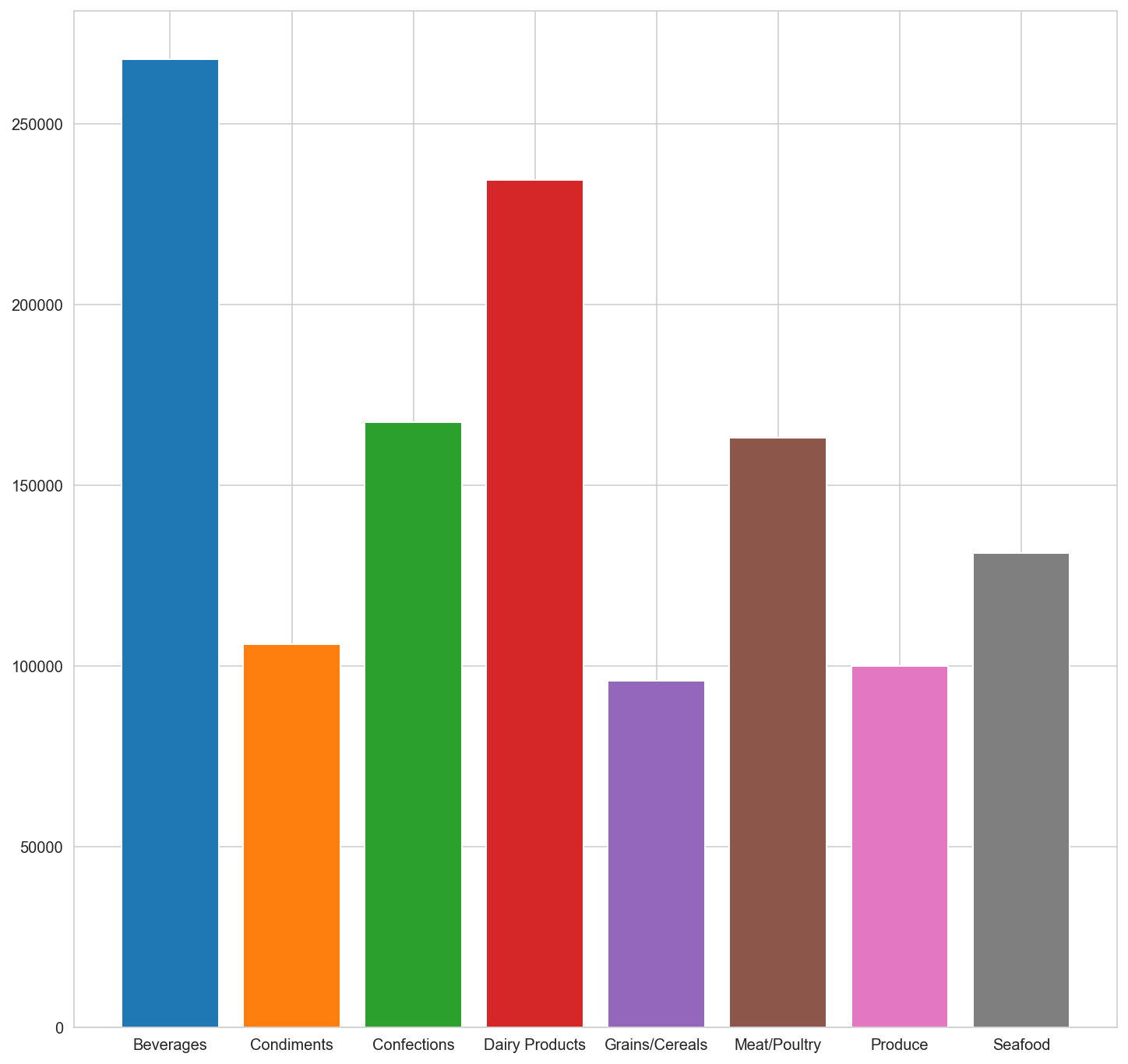
# What were the top 3 selling product categories in each region or country?
# What were the lowest 3 selling product categories in each region or country?
/\ _ _ _ *
/\_/\_____/ \__| |_____| |_________________________| |___________________*___
[===] / /\ \ | | _ | _ | _ \/ __/ -__| \| \_ _/ _ \ \_/ | * _/| | |
\./ /_/ \_\|_| ___|_| |_|__/\_\ \ \____|_|\__| \__/__/\_\___/|_|\_\|_|_|
| / |___/
|/